Avaya Canada IP1535 Video Telephone Unit User Manual
Avaya Canada Corporation Video Telephone Unit
User Manual
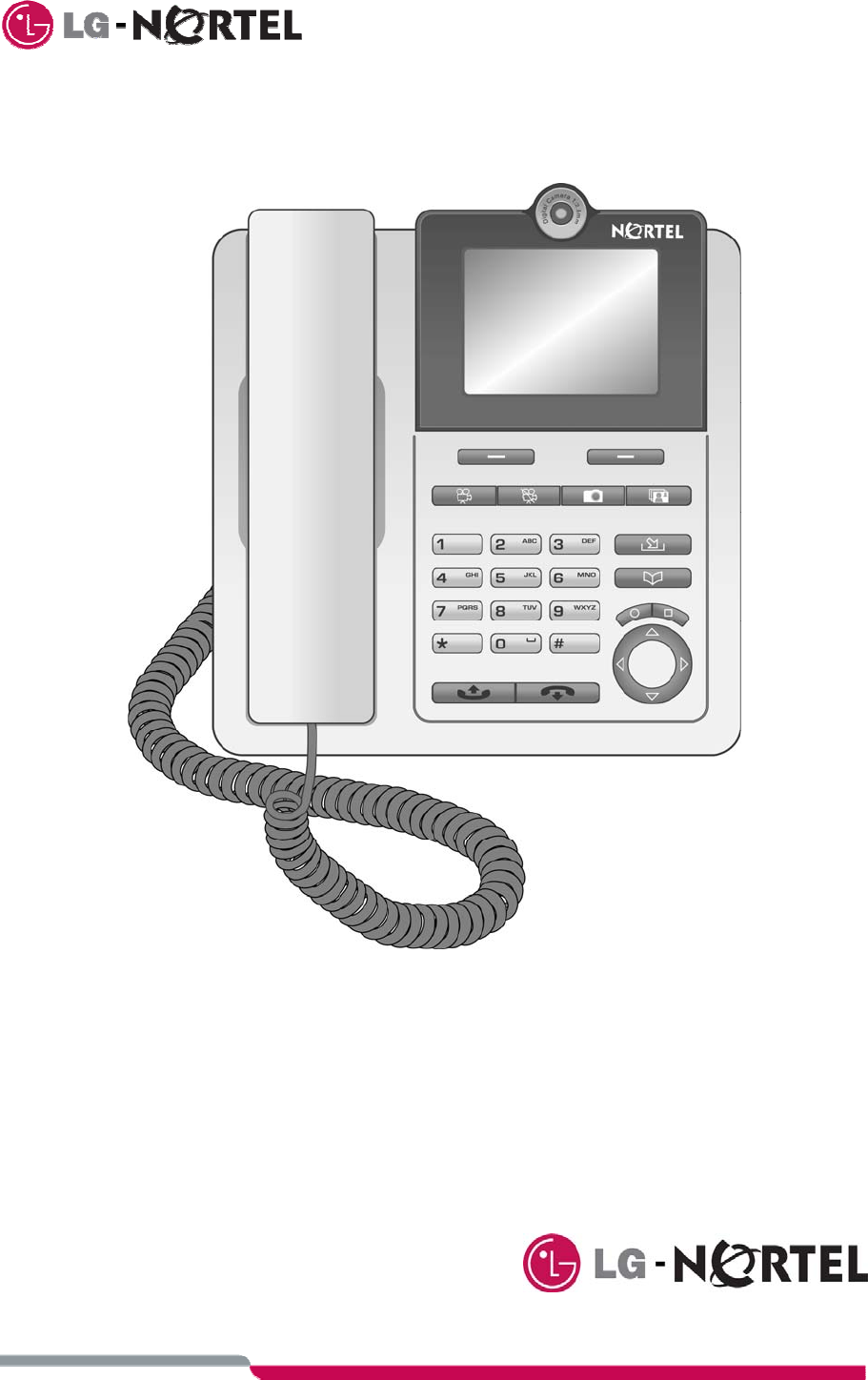
Rev. 0.01
IP Phone 1535 Videophone
User’s Manual

i
Table of Contents
1 Videophone Description ............................................................................ 1
1.1 Basic Description ................................................................................................................. 1
1.2 Description of the Keys........................................................................................................ 2
1.3 Screen Symbols................................................................................................................... 2
1.4 Care of the Videophone....................................................................................................... 2
1.5 Safety Information................................................................................................................ 3
1.6 Entering Characters with the Keyboard ............................................................................... 3
1.7 Shipping Box Content .......................................................................................................... 3
1.8 Factory Settings................................................................................................................... 3
1.9 Technical Specifications ...................................................................................................... 4
2 Installing .................................................................................................... 5
2.1 Installation Guidelines.......................................................................................................... 5
2.2 Installing the Videophone .................................................................................................... 5
2.2.1 Connecting the Handset.................................................................................................... 5
2.2.2 Connection to Power......................................................................................................... 5
2.2.3 PSTN Connection ............................................................................................................. 5
2.2.4 Broadband Connection ..................................................................................................... 5
3 Settings ..................................................................................................... 7
3.1 Profile Selection................................................................................................................... 7
3.2 Audio Settings...................................................................................................................... 8
3.2.1 Configuring Audio Volume ................................................................................................ 8
3.2.2 Ringing Options ................................................................................................................ 8
3.3 Video Options ...................................................................................................................... 9
3.3.1 Window Size .....................................................................................................................9
3.3.2 Camera On/Off.................................................................................................................. 9
3.3.3 Video fluency .................................................................................................................... 9
3.4 Personalize with Phone Settings ....................................................................................... 10
3.4.1 Display Options............................................................................................................... 10
3.4.2 Call barring ..................................................................................................................... 10
3.4.3 Language Selection ........................................................................................................ 11
3.4.4 Writing Mode................................................................................................................... 11
3.5 Adjusting VoIP ................................................................................................................... 11
3.5.1 User Information ............................................................................................................. 11
3.5.2 Proxy............................................................................................................................... 12
3.5.3 Registration..................................................................................................................... 12
3.5.4 Expires............................................................................................................................ 12
3.5.5 Miscellaneous ................................................................................................................. 12
3.5.6 Ports ............................................................................................................................... 13
3.5.7 Codec priority..................................................................................................................13
3.6 System Settings.................................................................................................................13
3.6.1 Reset .............................................................................................................................. 13
3.6.2 Admin mode.................................................................................................................... 14
3.6.3 Date and time.................................................................................................................. 14
3.6.4 Network parameters........................................................................................................ 14
3.6.5 WiFi parameters.............................................................................................................. 15
3.6.6 Modifying the system PIN ............................................................................................... 15
3.6.7 System Version Control .................................................................................................. 15
4 Voice Calls .............................................................................................. 16
4.1 Placing a call...................................................................................................................... 16
4.1.1 Pre-dial (Cell phone style)............................................................................................... 16
4.1.2 Recall Dialing ..................................................................................................................16
4.1.3 Phonebook Dialing.......................................................................................................... 16
4.1.4 Call Logs Dialing ............................................................................................................. 16

ii
4.2 Incoming Calls ................................................................................................................... 16
4.2.1 Receiving a Call .............................................................................................................. 16
4.2.2 Missed Call Notification/Return ....................................................................................... 17
4.3 Active Call Options ............................................................................................................ 17
4.3.1 Phonebook access.......................................................................................................... 17
4.3.2 Mute the microphone ...................................................................................................... 17
4.3.3 Audio volume .................................................................................................................. 17
4.3.4 Call hold.......................................................................................................................... 17
4.3.5 Blind transfer................................................................................................................... 18
4.3.6 Consultation transfer....................................................................................................... 18
4.3.7 Conference ..................................................................................................................... 18
4.3.8 Show hw/sw Version....................................................................................................... 18
4.3.9 Telephone number.......................................................................................................... 18
5 Video Calls .............................................................................................. 19
5.1 Making a Video Call........................................................................................................... 19
5.1.1 Direct Video Call ............................................................................................................. 19
5.1.2 Indirect call...................................................................................................................... 19
5.2 Receiving a Video Call....................................................................................................... 19
5.3 Video Call Controls ............................................................................................................ 19
5.3.1 Video Privacy (Mute)....................................................................................................... 19
5.3.2 Video Window Size ......................................................................................................... 19
5.4 Active Video Call Options .................................................................................................. 20
5.4.1 Show/hide Details ........................................................................................................... 20
5.4.2 Video fluency .................................................................................................................. 20
5.4.3 Phonebook...................................................................................................................... 20
5.4.4 Mute the Microphone ...................................................................................................... 20
5.4.5 Audio Volume.................................................................................................................. 20
5.4.6 Show hw/sw version........................................................................................................ 20
5.4.7 Telephone number.......................................................................................................... 20
6 E-Mail Messages Menu........................................................................... 21
6.1 Configuring E-Mail ............................................................................................................. 21
6.2 E-mail Menu Options ......................................................................................................... 21
6.2.1 Writing an email .............................................................................................................. 21
6.2.2 Sending & Saving an E-Mail ........................................................................................... 21
6.3 Accessing saved E-Mails................................................................................................... 22
6.4 Reading New E-Mails ........................................................................................................ 22
6.5 E-Mail Management Options ............................................................................................. 22
7 Services Menu ........................................................................................ 23
7.1 Voice Mail .......................................................................................................................... 23
7.1.1 Configuring Voice Mail .................................................................................................... 23
7.1.2 Accessing Voice Mail ...................................................................................................... 23
7.2 Web browser...................................................................................................................... 23
7.3 Video Monitoring................................................................................................................24
8 Call History.............................................................................................. 25
8.1 Viewing Call Logs .............................................................................................................. 25
8.2 Call Log Options ................................................................................................................25
8.2.1 Details............................................................................................................................. 25
8.2.2 Saving in the Phonebook ................................................................................................ 25
8.2.3 Delete a Call Record ....................................................................................................... 26
8.2.4 Call.................................................................................................................................. 26
8.3 Deleting Call History Logs ................................................................................................. 26
9 Images and Sounds ................................................................................ 27
9.1 Image Galleries.................................................................................................................. 27
9.1.1 Taking Photos................................................................................................................. 27
9.1.2 Administrating images..................................................................................................... 27

iii
9.2 Sound Galleries .................................................................................................................28
9.2.1 Recording Audio ............................................................................................................. 28
9.2.2 Administrating sounds..................................................................................................... 28
9.3 Video Gallery ..................................................................................................................... 29
9.3.1 Recording Videos............................................................................................................ 29
9.3.2 Administrating videos ...................................................................................................... 29
10 Calendar.................................................................................................. 30
10.1 Creating a new alarm......................................................................................................... 30
10.2 Options available ...............................................................................................................30
10.3 Deleting an Alarm .............................................................................................................. 30
11 Phonebook .............................................................................................. 31
11.1 Adding an entry.................................................................................................................. 31
11.2 Consulting the Phonebook................................................................................................. 31
11.2.1 Access Phonebook Records ........................................................................................... 31
11.2.2 Quick Access to the Phonebook ..................................................................................... 31
11.3 Modifying an entry ............................................................................................................. 32
11.4 Deleting an entry................................................................................................................ 32
11.5 VIP list................................................................................................................................ 32
12 SIM Card ................................................................................................. 33
12.1 Copying entries from the SIM card .................................................................................... 33
12.2 Copying entries to the SIM card ........................................................................................ 33
13 SD/MMC.................................................................................................. 34
13.1 Copying files from the Memory card .................................................................................. 34
13.2 Copying files from the videophone to an SD/MMC memory card...................................... 34
14 Maintenance and Problem Solving.......................................................... 35
14.1 What Videophone version do I have?................................................................................ 35
14.2 Updating the Phone’s software.......................................................................................... 35
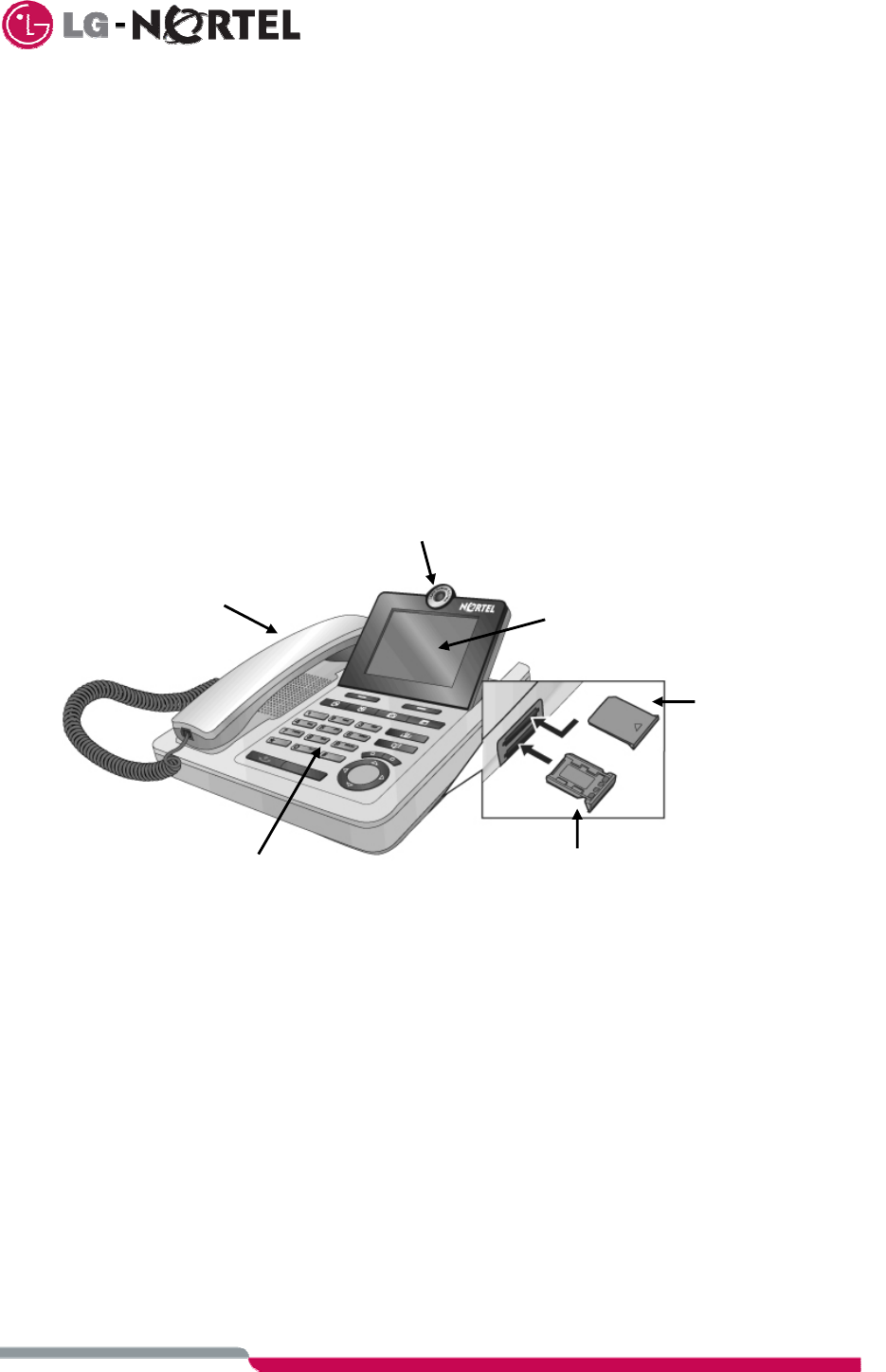
1
1 Videophone Description
1.1 Basic Description
The IP PHONE 1535 is a hybrid PSTN and IP based phone that permits audio and video calls and access to
special services available from your communications provider. The IP PHONE 1535 incorporates the
following elements as shown in Fig. 1:
• Alphanumeric dial pad.
• Soft keys, located below the screen, interact with the menu to simplify operation.
• Color TFT LCD, 3.5 inch, QVGA (320 x 240 pixels)
• Digital camera, 1/4.5 inch, 640x480 pixels.
• Handset
• Speaker & Microphone.
• Fast Ethernet port and internal WiFi module for Internet connection.
• USIM (Unified Subscriber Identification Memory) slot for data exchange with Phonebook.
• SD/MMC (Secure Digital Multi-Media Card) slot for data exchange with multimedia devices.
Fig. 1. Front view of the Videophone
T
Te
el
le
ep
ph
ho
on
ne
e
d
di
ia
al
l-
-p
pa
ad
d
T
Te
el
le
ep
ph
ho
on
ne
e
h
ha
an
nd
ds
se
et
t
C
Ca
am
me
er
ra
a
S
SD
D/
/M
MM
MC
C
C
Ca
ar
rd
d
T
Tr
ra
ay
y
S
SI
IM
M C
Ca
ar
rd
d
T
Tr
ra
ay
y
C
Co
ol
lo
or
r
G
Gr
ra
ap
ph
hi
ic
cs
s
S
Sc
cr
re
ee
en
n
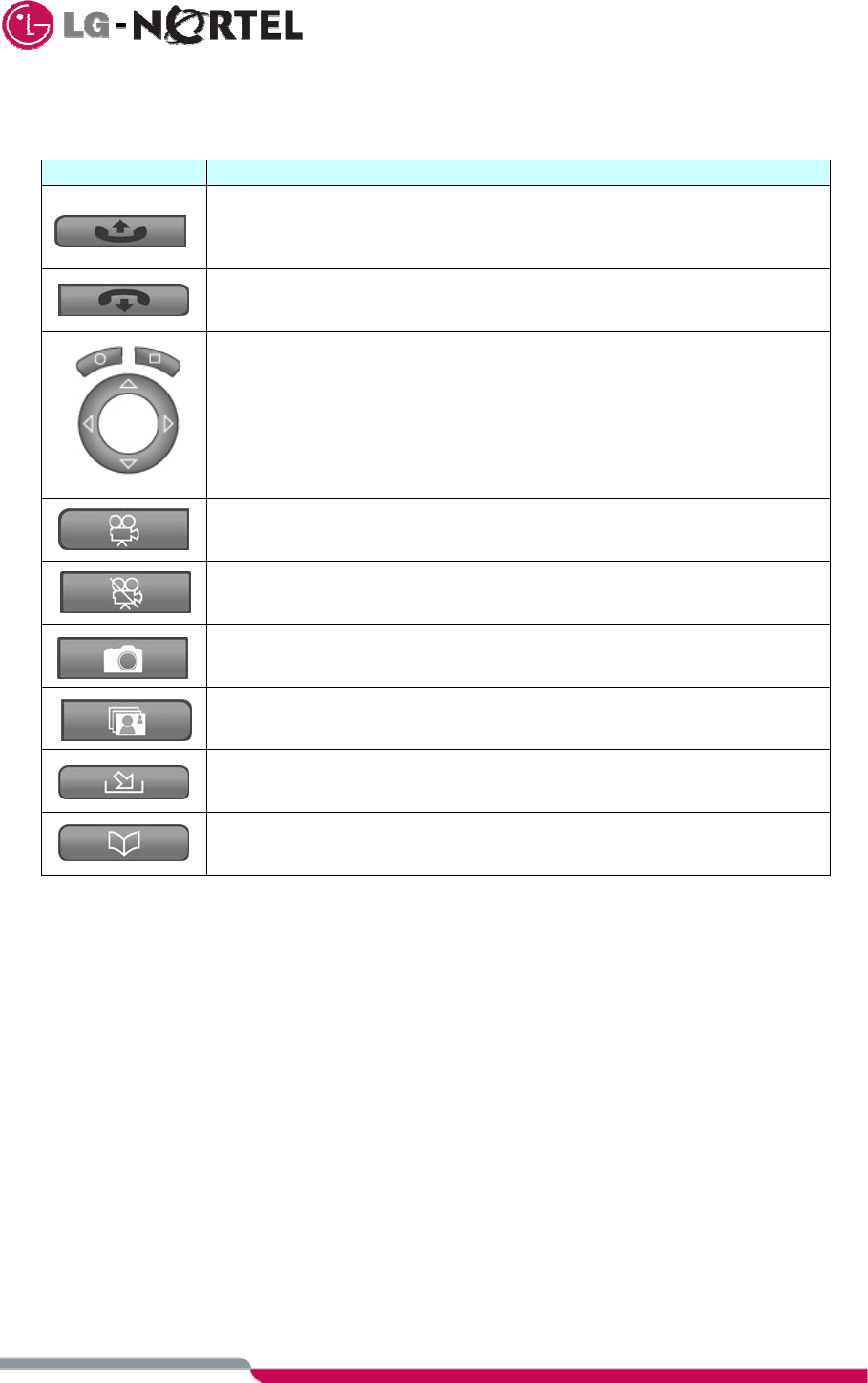
2
1.2 Description of the Keys
Key Function
Speakerphone off-hook button.
With Handset on-hook, activates Speakerphone.
With Handset off-hook, switches to Speakerphone operation.
Call release button. While using the Speakerphone, this button will end the
call. Also, while browsing menus, this button will return to the previous menu.
Navigation buttons. Controls movement through the various menus.
In the idle screen:
c Enables direct access to outgoing calls history
d Enables direct access to the phone book
Video Call Button. Lets you place a video call or request Video call.
Also used to accept a Video call request.
Video Mute button. Lets you stop (mute) and restart video transmission
during a video call.
Camera button. Gives access to camera, and audio and video recorder.
On a video call, controls video window size.
FAVOURITES button. Gives direct access to browser Favourites.
MESSAGES button, gives access to voice mail service.
Table 1 Videophone buttons
1.3 Screen Symbols
The telephone has a color screen displaying different icons giving you information on the Videophone’s
various events and status. The meaning of these will be detailed throughout this manual.
1.4 Care of the Videophone
The Videophone should only be cleaned with a moist or anti-static cloth. Do not use detergents or solvents.
Avoid using dry cloths as they can generate static electricity, which can be potentially dangerous for the
electrically sensitive parts of the Videophone.
When used in near proximity to electromagnetic sources such as Microwave ovens, audio interference may
result; relocate the device to minimize interference.

3
1.5 Safety Information
The Videophone complies with CEI EN60950 “ITE safety” regulations (IT equipment).
For safety reasons, do not use the telephone in bathrooms or very humid environments, as it is not
waterproof.
1.6 Entering Characters with the Keyboard
To enter any type of text (a name, an email address in the phonebook, etc.), follow the same procedure as for
any mobile telephone.
When writing text, you have the following options:
• Modify writing mode: if you want to modify the character set (mode), press the # key to run through the
various options. A symbol on the screen will tell you which writing mode you have selected at any
given time. For further information, see section 3.4.4 Writing mode.
• Insert symbols: if you want to insert a symbol, press the * key to view the available symbols. Move
through them, choose the desired symbol and select with OK.
• Delete text: a “Delete” option will always be available. Pressing it once deletes a single character. If
you press and hold the “Delete” for a few seconds, the entire text string is deleted.
• Insert a space: press the * key or, in all writing modes other than 123, press 0.
1.7 Shipping Box Content
The shipping box contains:
• 1 IP PHONE 1535 telephone base
• 1 handset
• 1 LAN cable
• 1 power adaptor: 100V~240V, 50Hz~60Hz
• 1 user manual
1.8 Factory Settings
The Videophone is delivered with the following settings:
• Ring tone volume: level 4
• Handset / hands free volume: level 4
• Date: 01/01/2006 (MM/DD/YYYY)
• Time: 00:00 (HH:MM)
• Ringing mode: standard
• VIP filter: disabled
• Video quality: level 4
• Video fluidity: 3
• Screen size: remote/local small
• Screen color: default
• Screen background: default
• Screensaver: enabled
• PIN: 0000

4
1.9 Technical Specifications
Videophone base size: 206 x 190 x 100 mm.
Handset size: 184 x 42 x 32 mm.
Approximate weight: 750 + 195 g (base + handset)
Main processor: Intel PXA270 @ 416 MHz
PSTN port RJ-11
LAN port: RJ-45
WLAN interface: IEEE802.11b/g
SD/MMC slot
SIM slot
Ring melodies: 50 polyphonic
Background images: 5
Operating temperature: 0° C- 40° C
Operating humidity: 5 ~ 95 %, non-condensing
Noise level: 15 dB @ 1 m
Dialing Mode: DTMF (Dual Tone Multi-frequency)
Power: AC/DC Adapter
AC Input- 100~240 VAC 60Hz
DC Output 5 VDC 1.5 Amps

5
2 Installing
2.1 Installation Guidelines
• The Videophone can be used in a temperature range of +0° to 40° C and a 5 to 95% relative humidity.
• Place the telephone on a smooth non-slip surface.
• Do not place the Videophone in particularly dusty environments, as the build up of dust deposits can
affect the working of the mechanical parts subject to movement.
• Make sure the Videophone is not directly exposed to sunlight or direct, irradiated heat sources as this
can damage electrical components over time.
2.2 Installing the Videophone
Basic installation of the IP PHONE 1535 is simply a matter of connecting the ports of the phone to the correct
socket with standard connector ended cables. Connections are made for the Handset, Power and, as
needed, PSTN and LAN.
2.2.1 Connecting the Handset
• Insert one end of the coil cord in the handset connector on the handset cradle side of the
Videophone (see fig. 2).
• Insert the other end of the coil cord in the handset connector (see fig.2).
2.2.2 Connection to Power
• Insert the power adaptor DC plug in the DC power jack in the rear of the Videophone (see fig. 2).
• Connect the adaptor’s AC plug into an appropriate AC voltage socket.
Note use only the adaptor delivered as other adaptors may cause operating anomalies, hazardous
conditions and/or material damage.
2.2.3 PSTN Connection
• Insert one end of the Telephone line cord in the PSTN connector located at the rear of the
Videophone base (see fig. 2).
• Insert the other end of the Telephone line cord in the local PSTN connection.
2.2.4 Broadband Connection
2.2.4.1 LAN Connection
• Insert the RJ45 terminated LAN cable in the LAN (Local Area Network) port located at the
back of the Videophone base (see fig. 2).
• Connect the other end of the LAN cable in the local LAN connection.
2.2.4.2 WiFi Connection
The Videophone can be connected to the Broadband LAN via a wireless WiFi connection. To do this you
must have a wireless router or access point. Normally, the Videophone will automatically locate and
register with the WiFi source. In some cases it may be necessary to configure the Videophone WiFi
parameters, see section 3.6.5
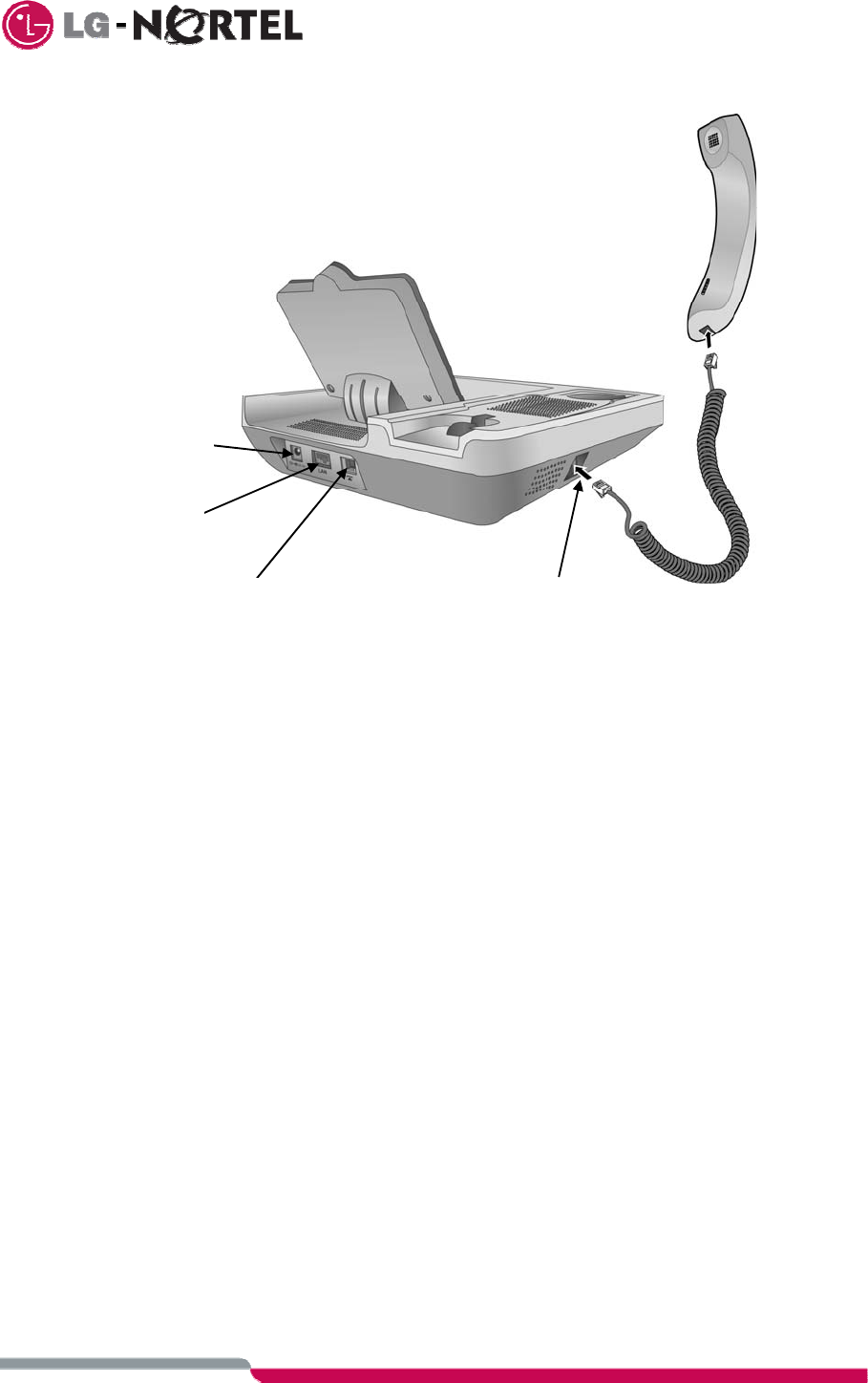
6
Figure 2 IP PHONE 1535 Installation
Power
Connection
LAN
Conncetion
PSTN Line
Conncetion Handset Conncetion
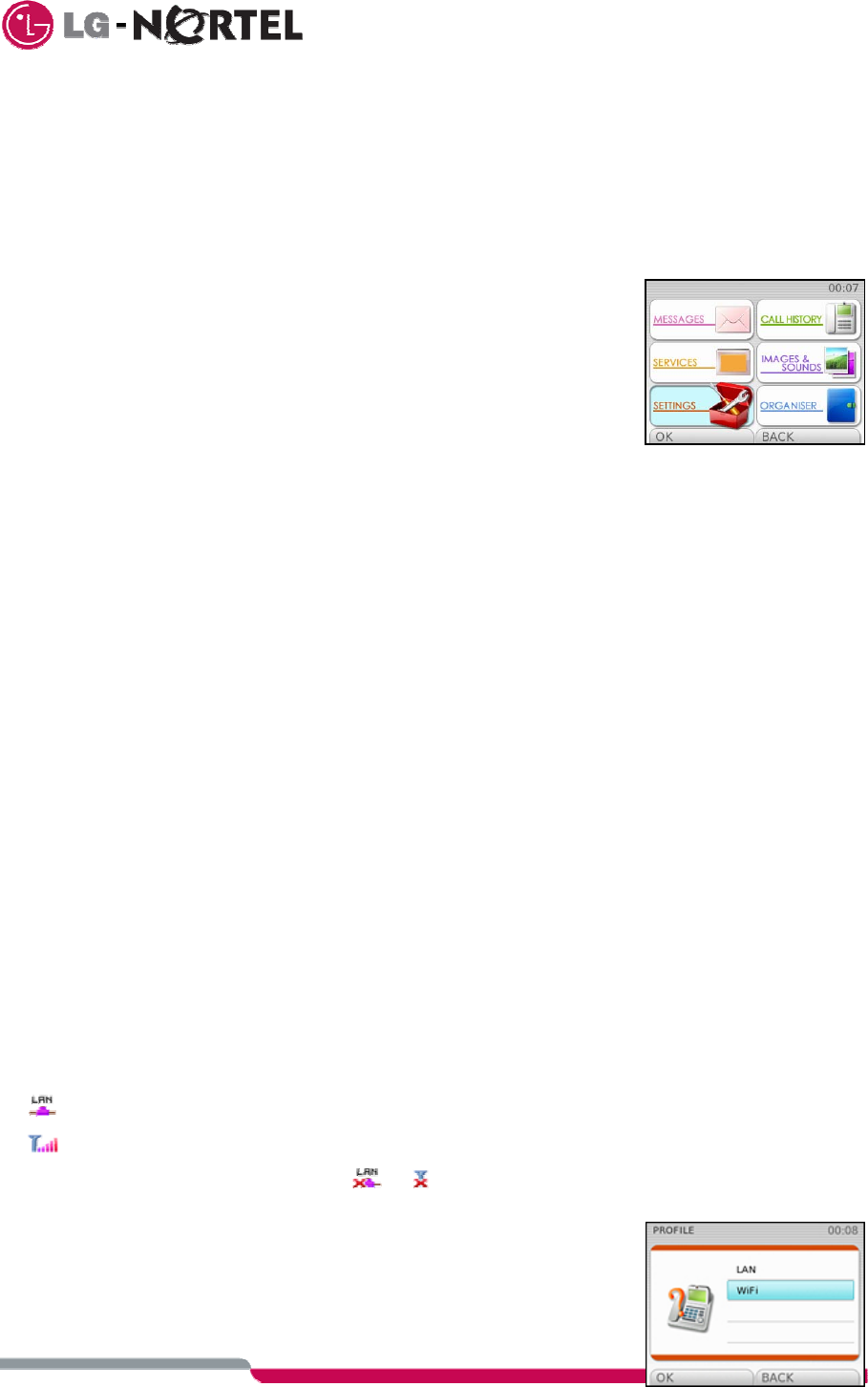
7
3 Settings
By default, the IP PHONE 1535 is set to function in the narrowband mode connected to a PSTN line and
there is no need for further configuration. These and other settings may be changed in the “SETTINGS”
menu. The “SETTINGS” Menu is accessed from the idle screen by selecting settings from the main menu.
When you select the main menu, you see the selections as below. The main menu selections available
are:
• Messages: access to the Email options.
• Call history: access to missed, Dialed (outgoing) and received call
logs.
• Services: access to the browser, voice mail, and video monitoring
services.
• Images and sounds: access to the multimedia functions including
image, audio and video gallery.
• Settings: access to the IP PHONE 1535 configuration parameters
including profiles, audio, video, phone, VoIP and system parameters.
• Organizer: access to IP PHONE 1535 Phonebook and Calendar.
Under “SETTINGS” the following list is displayed on the right hand side of the screen:
• Profile: to select the telephone’s operating profile (LAN and WiFi). See section 3.1 Profile selection.
• Audio settings: configure ringing and audio parameters, see section 3.2.
• Video settings: configure the video size and fluidity, see section 3.3.
• Phone settings: modify telephone-related parameters (language, screen options, etc), see section
3.4.
• VoIP settings: modify VoIP parameters. See section 3.5 Setting VoIP.
• System settings: modify system-related parameters (date, time, network parameters, etc.). See
section 3.6 System settings.
3.1 Profile Selection
In place of the narrowband mode, the IP Phone 1535 may operate in either of two broadband modes or
“Profiles”.
• LAN broadband profile: the Videophone is connected to the broadband network via an Ethernet
connection at an Ethernet Switch or router.
• WiFi broadband profile: the Videophone is connected to the broadband network via a wireless WiFi
connection. To do this, a wireless router or access point must serve as a bridge connection to the
broadband network.
When you select a profile, both Voice and Video calls are made via the interface corresponding to the
selected profile and the remaining profile is disabled. Once you have activated the profile, an icon indicating
the type of profile selected will appear in the top bar of the main page.
() LAN icon
() WiFi icon
If a problem exists in the connection, the ( or ) icon will appear, indicating no connectivity.
To select the broadband profile select: “main menu” → “settings” →
“profile”:
1. Select “LAN or WiFi and press OK
2. Select “Enable” to activate this interface.
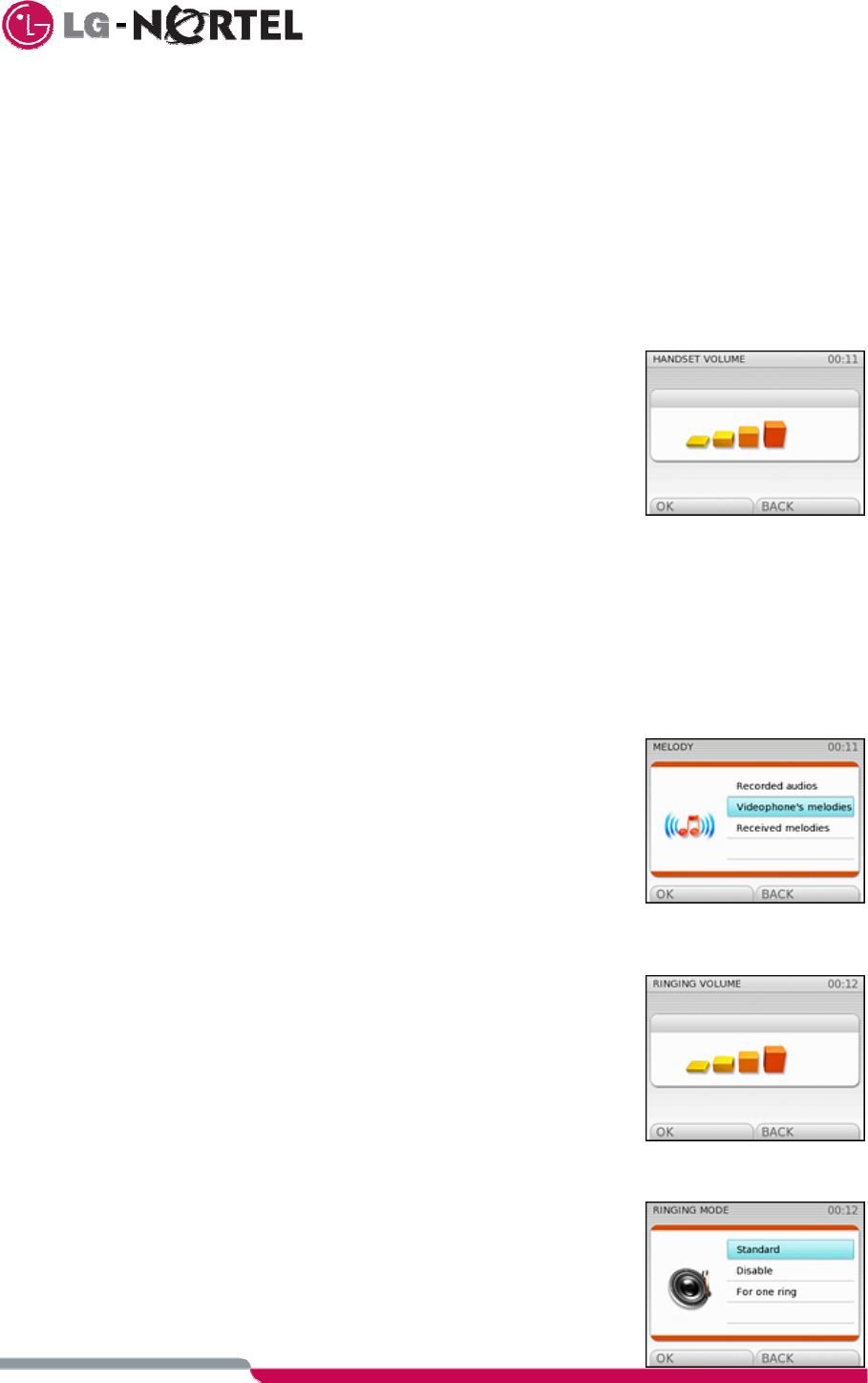
8
3. When asked to confirm the change, press “YES”.
Enabling the a broadband profile may require configuring the parameters for “Network Parameters” or “WiFi
Parameters”, see sections 3.6.4 or 3.6.5 respectively. If this configuration is required, the (icon) icon will
appear, indicating this situation.
3.2 Audio Settings
3.2.1 Configuring Audio Volume
With this function you can set audio volume during normal audio calls and video calls for handset and
hands free conversations. To set audio volume:
1. From the idle screen, select “main menu” → “settings” →
“audio settings” → “handset volume” or “speaker volume”
and press OK to confirm.
2. The default volume may be set to one of five levels using the
vertical arrow keys.
3. Confirm with OK.
Note the volume level may be increased or decreased from the normal level any time during a
conversation, within the five levels available.
3.2.2 Ringing Options
3.2.2.1 Configuring Ring melody
The IP PHONE 1535 Audio gallery includes 50 (fifty) melodies that can be used for ring. Each melody is
8 seconds long and an additional 60 (sixty) melodies may be downloaded from a SD/MMC card or
recorded from the IP PHONE 1535. To use the built-in melodies follow the procedure below. To store a
melody in the Phone see section 9.
1. From the idle screen, select “main menu” → “settings” →
“audio settings” → “ringing” → “melody” and press OK to
confirm.
2. Search for the desired melody, select and confirm with OK.
3. Press “Set” to apply the melody as the ring tone.
3.2.2.2 Setting default Ringing volume
The initial ring default volume for the Videophone can be set at one of 5 different levels. To regulate the
default ring volume:
1. From the idle screen, select “main menu” → “settings” →
“audio settings” → “ringing volume” and press OK to confirm.
2. Adjust the volume using the vertical arrows. There are 5 levels
available.
3. Press OK to confirm the selection.
3.2.2.3 Configuring Ringing mode
The Videophone’s ring can be set to 4 different modes. To select a ring mode:
1. From the idle screen, select “main menu” → “settings” →
“audio settings” → “ringing” → “ringing mode” and press OK
to confirm.
2. Select one of the following options:
• Standard: sets normal ringing.
• Disable: mutes ringing at all times, do-not-disturb.
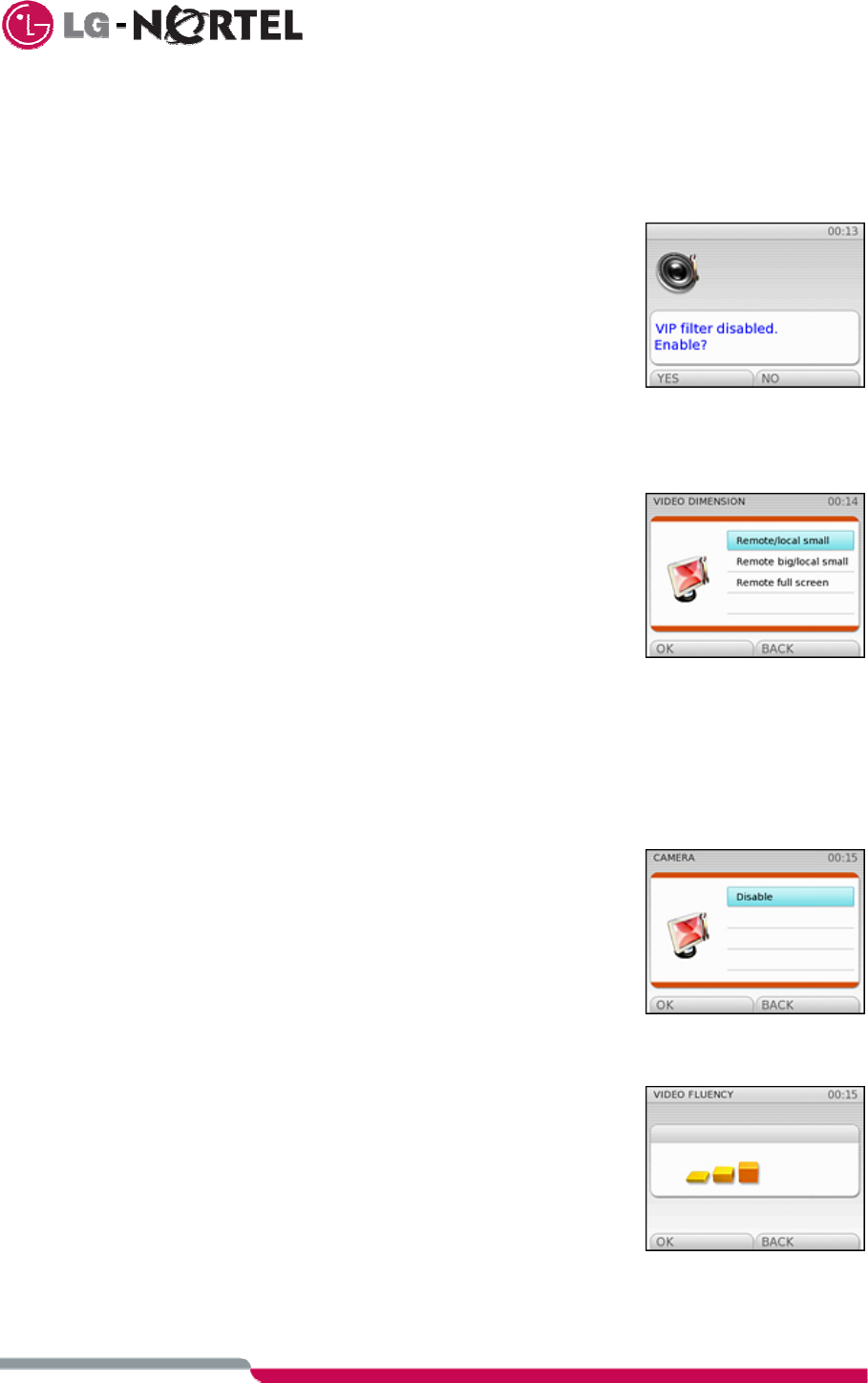
9
• For one ring: ring for the first ring only, one-time.
3. Press OK to confirm the desired ring mode.
3.2.2.4 Ring Filter for VIP calls
This parameter enables operation of the VIP filtering. When enabled, only calls from callers identified as
a VIP in the Phonebook will provide audible ringing. Note that CLI (Calling Line Identification) service
must be available. VIPs are defined as shown in section 11. To enable the
filter for VIP calls:
1. From the idle screen, select “main menu” → “settings” →
“audio settings” → “ringing” → “VIP filter” and press OK.
2. Press “YES” to confirm or “NO” to cancel and return to the
previous menu.
3.3 Video Options
3.3.1 Window Size
During a Video call the screen is divided into two windows, local and remote. The size of the window
remote and local windows is adjustable. To set Window size dimension:
1. With the Videophone idle, select “main menu” → “settings” →
“video settings” → “video dimension” and press OK.
2. Select the desired size using the vertical arrows. The options
available are:
• Remote/local small: both images are displayed in a small
frame. (Default)
• Remote big/local small: remote party’s image is displayed in
full screen, while your own image is seen in a small frame.
• Remote full screen: remote party’s image is displayed in full screen.
3. Press OK to confirm.
3.3.2 Camera On/Off
The camera can be turned off so that the video and photo functions of the IP PHONE 1535 are disabled.
This parameter can only be accessed if the user has logged in to Admin, see section 3.6.2. To
enable/disable the camera:
1. With the Videophone idle select “main menu” → “settings” →
“video settings” → “camera” and press OK.
2. Select enable or disable and press OK to confirm.
If the Camera is turned off, Photos, Video recorder and Video Monitoring
features are not available, and during a video call, the local image will not be
sent to the remote user.
3.3.3 Video fluency
With this function you can set the image fluency level (choosing from five
different values) during a video call. Modifying this parameter allows you to
increase or decrease the fluency of the image transmitted during a Video
call. This parameter is also determined by the definition with which the
image is sent. In fact, the greater the reproduction speed (fluency), the
lower the image quality.
To set the video fluency:
1. With the telephone idle press “main menu” → “settings” → “video settings” → “video
fluency” and press OK.
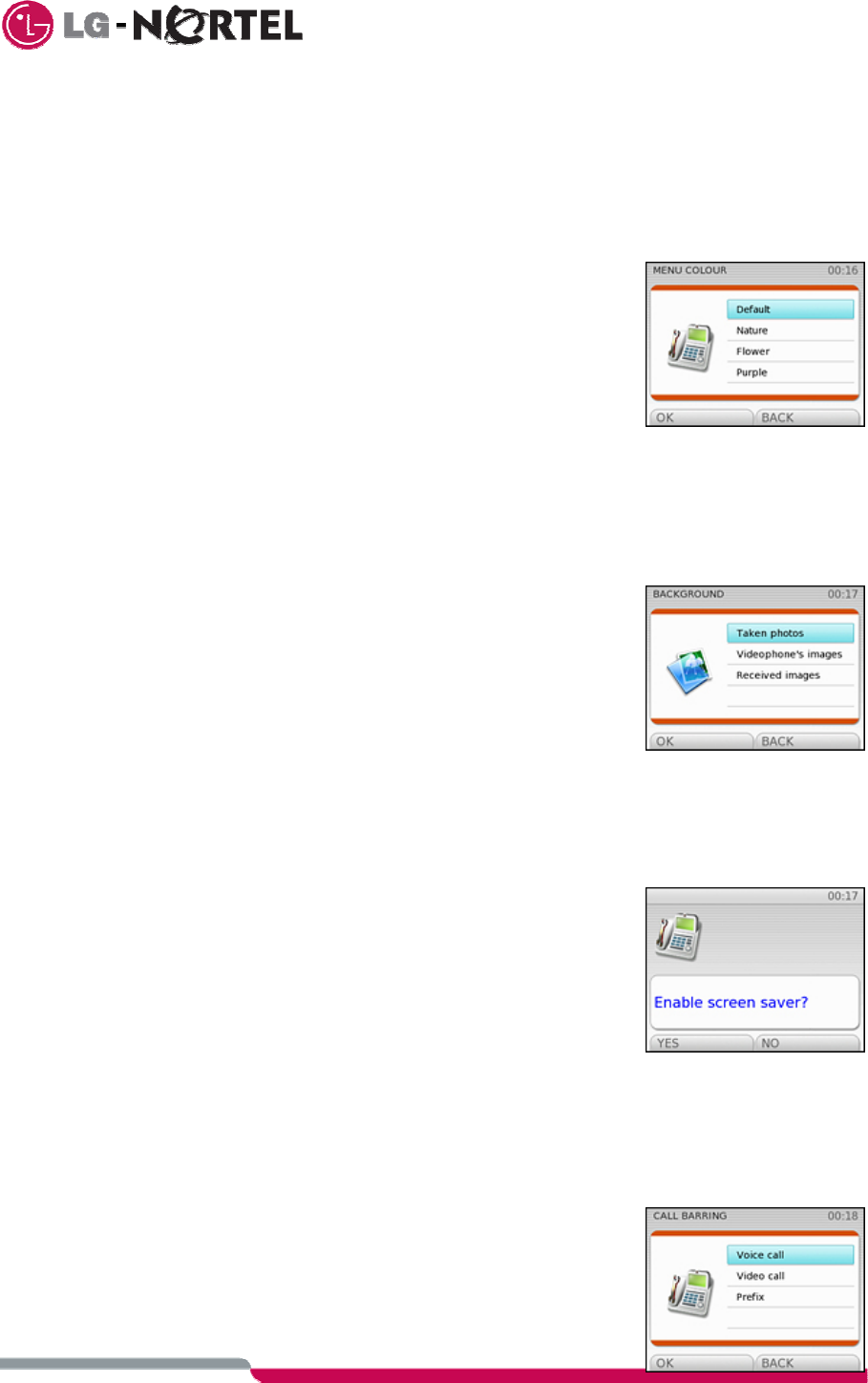
10
2. Select the desired level using the vertical arrows. There are 5 levels available.
3. Press OK to confirm.
3.4 Personalize with Phone Settings
3.4.1 Display Options
3.4.1.1 Display Color
To personalize the display several background color choices are available. To modify the screen color:
1. With the telephone idle, select “main menu” → “settings” →
“phone settings” → “display” → “menu color” and press OK.
2. Select the desired color using the vertical arrows. The options
available are:
• Default
• Nature
• Flower
• Purple
3. Press OK to confirm.
3.4.1.2 Background
With this function you can select the screen’s background image.
To modify the background image:
1. With the telephone idle select “main menu” → “settings” →
“phone settings” → “display” → “background” and press OK.
2. Select the desired image from one of the following galleries:
• Photos
• IP PHONE 1535 images
• Stored images
3. Press OK to confirm your selection.
3.4.1.3 Screen Saver
After a period of inactivity, Screensaver switches the IP PHONE 1535 display screen off. The user can
enable or disable the Screensaver function and define the Screensaver delay period.
To enable the Screensaver function:
1. With the telephone idle select “main menu” → “settings” →
“phone settings” → “display” → “screen saver” and press OK.
2. Press “YES” to confirm or “NO” to cancel and return to the
previous screen.
3. When changing to an enabled state, the screensaver delay
interval is requested. Use the dial pad to enter the delay time
interval (minutes: seconds)
4. Confirm with OK.
3.4.2 Call barring
The IP PHONE 1535 can bar or block outgoing calls where the first few digits match a pre-defined “prefix
code” Up to five prefix codes of up to 5 digits each can be entered for Call Barring. To configure call
blocking:
1. With the telephone idle select “main menu” → “settings” →
“phone settings” → “call barring” and press OK.
2. The user’s PIN (default = 0000) is requested. Enter the valid PIN
and Confirm with OK.
3. Select “Prefix”.
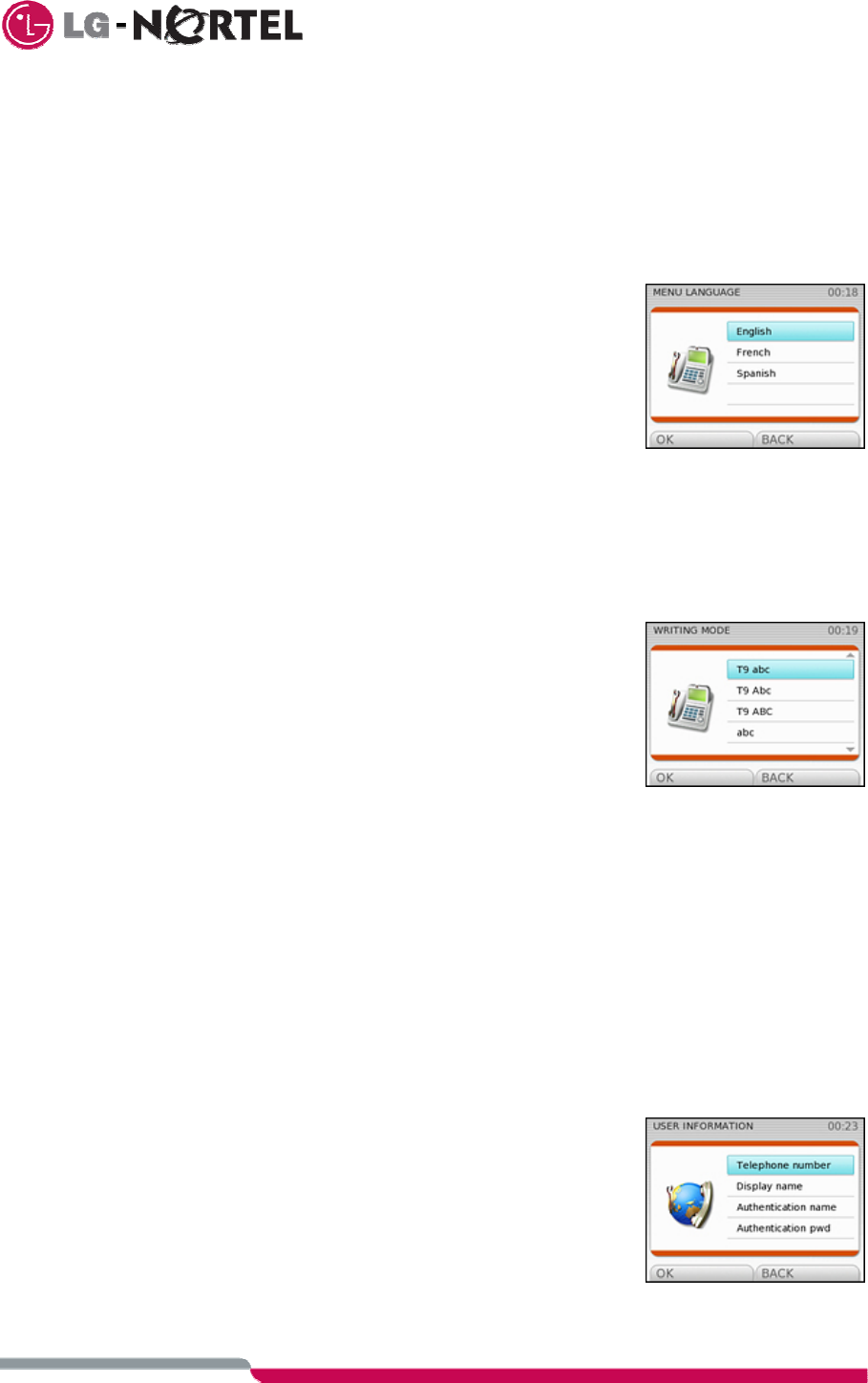
11
4. Select one of the 5 prefix code indices.
5. Enter the prefix code to be barred, up to 5 digits, and press OK to confirm.
6. If you wish to restrict voice calls only, select “voice call” → “enable”, to restrict video calls only,
select “video calls” → “enable”.
3.4.3 Language Selection
The IP PHONE 1535 displays can be in several languages to meet the user needs. The languages
available are English (default), French, and Spanish. To modify the
language:
1. With the telephone idle select “main menu” → “settings” →
“phone settings” → “menu language” and press OK.
2. Select the desired language from English, French, or Spanish
using the vertical arrows.
3. Press OK to confirm.
3.4.4 Writing Mode
The user can set the start-up Writing mode used during dial pad character entries. The user assigns the
start-up mode to employ small or capital letters. The user may also select the T9 look-ahead dictionary,
which compares entries to a dictionary to pre-determine a desired entry thus, easing user entry.
To set the writing mode:
1. With the telephone idle select “main menu” → “settings” →
“phone settings” → “writing mode” and press OK.
2. Select one of the 4 options available:
• Dictionary T9 in small letters
• Dictionary T9 in capital letters
• Small letters
• Capital letters
3. Press OK to confirm.
When using the dial pad for entries, such as in the Phonebook, the user may change the Writing mode as
needed.
3.5 Adjusting VoIP
Normally, the VoIP settings of the IP PHONE 1535 are properly set through default and automated
registration with your service provider.
Should it be necessary to modify them, you can do this from “main menu” → “settings” → “VoIP settings”.
3.5.1 User Information
To modify information relating to the user, from “main menu” → “settings” → “VoIP settings”:
1. Select “User Information” and press OK.
2. Select the desired parameter and press OK.
• Telephone number
• Display name
• Authentication name
3. Enter parameters data and confirm with OK:
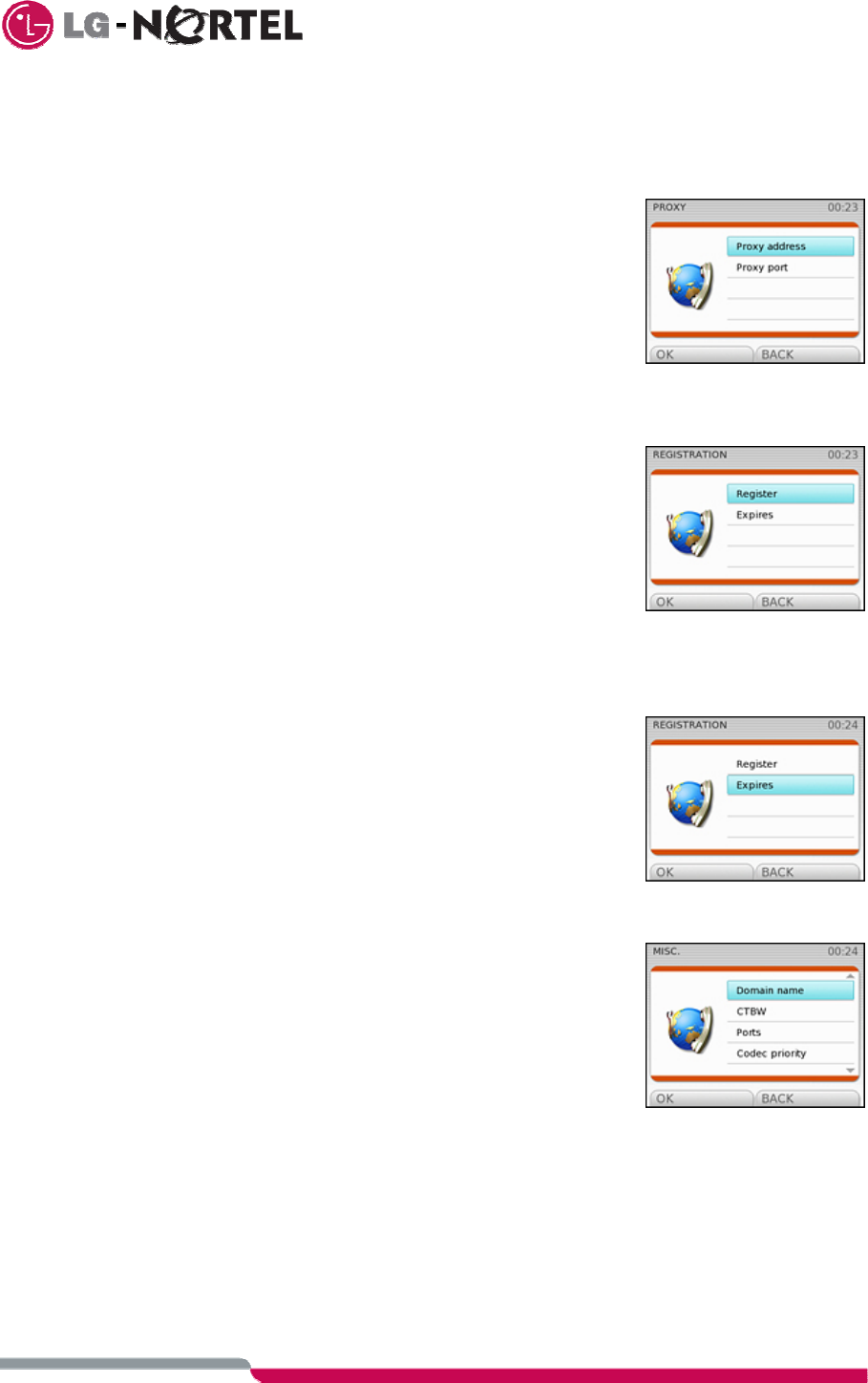
12
3.5.2 Proxy
To modify the SIP proxy parameters, from “main menu” → “settings” → “VoIP settings”:
1. Select “Proxy” and press OK.
2. Select the parameter you wish to modify and make the desired
changes. Modifiable parameters are:
• Proxy port: default is 5060
• NAT/Timer: set to keep broadband connectivity through a
firewall. The options are 30 secs., 45 secs., 1 min., 1.5 min., 2
min., 2.5 min., 3 min., and 5 min.
3.5.3 Registration
If a broadband profile, section 3.1, Network Parameter, section 3.6.4 or WiFI parameter, section 3.6.5 is
changed, the phone must be re-registered with the service provider for
proper operation,
To manual register the IP PHONE 1535, from “main menu” → “settings” →
“VoIP settings”:
1. Select “Registration” and press OK.
2. Select “Register” and press OK.
3.5.4 Expires
For SIP service, the end-point must periodically register with the SIP server to continue proper operation.
The IP PHONE 1535 can be configured with a preferred registration interval or Registration expiration
period. The IP PHONE 1535 will request the SIP server use this period as the expiration time.
To configure the Registration expiration time, from “main menu” →
“settings” → “VoIP settings”
1. Select “registration” → “expires”.
2. Enter a number in seconds between 60 and 7200 and press OK
to confirm.
3.5.5 Miscellaneous
To modify various options such as Domain name, CTBW and voice mail, from “main menu” → “settings”
→ “VoIP settings”:
1. Select “Misc” and press OK.
2. Select the parameter to modify:
• Domain name: to modify the domain name server.
• CTBW: to modify total average bandwidth for a conference
range 60 and 250 kbps.
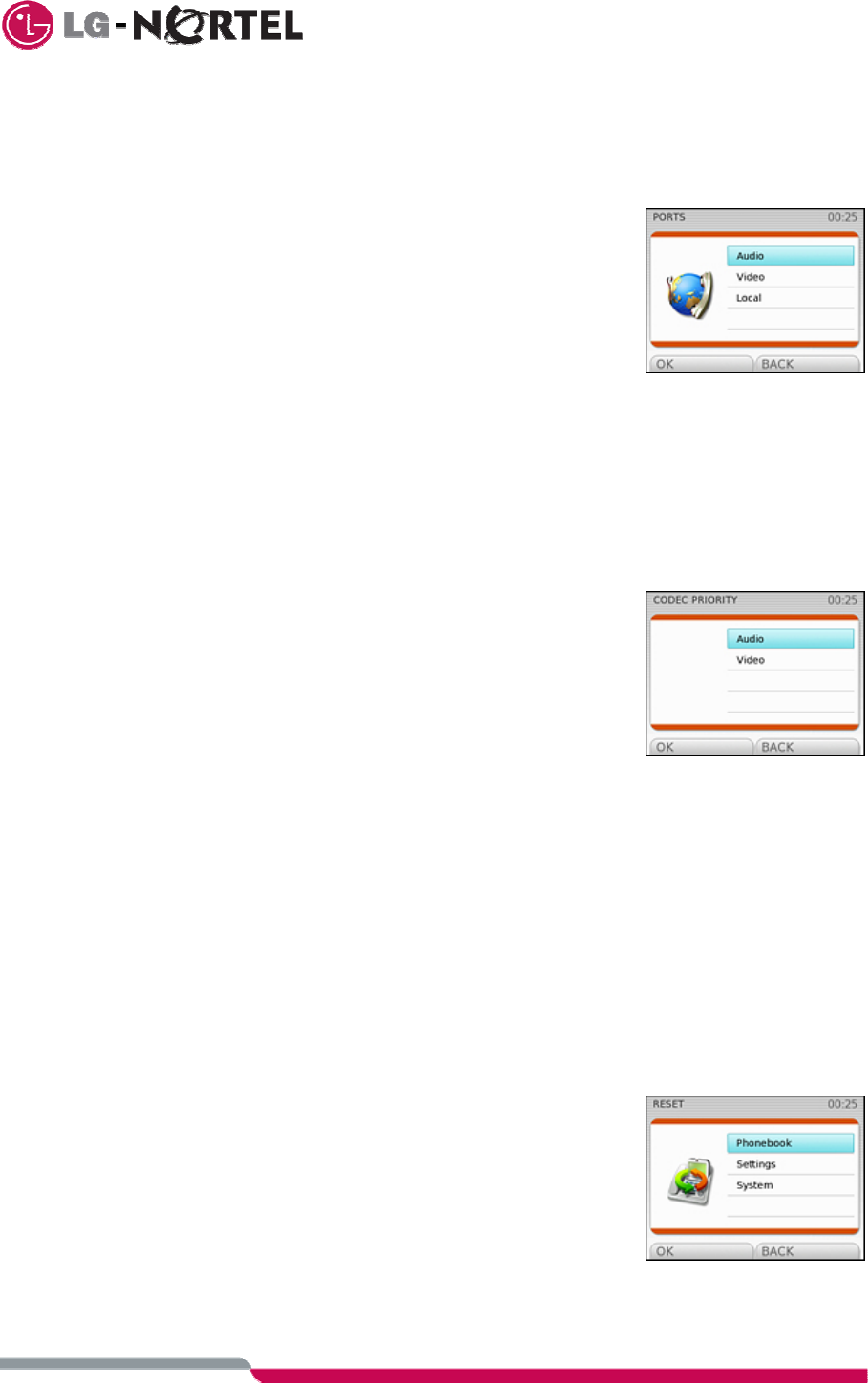
13
3.5.6 Ports
The TCP and UDP ports for real-time media (audio and video) and the SIP signalling ports can be
configured according to network environment. This parameter can only be accessed if the user has
logged in to Admin, see section 3.6.2. To modify the port assignment, from “main menu” → “settings” →
“VoIP settings” → “ports”:
1. Select the port type (“audio”, ”video” or ”local”).
2. Enter the desired port number, see below for range, and press
OK to confirm.
• Audio: default is 23000, and must be in range between 1024
and 65535
• Video: default is 24000, and must be in range between 1024
and 65535
• Local: default is 5060, and must be in range between 1024 and 65535. This port is used to
connect with proxy server.
3.5.7 Codec priority
Codec priority can be adjusted according to the network environment. This parameter can only be
accessed if the user has logged in to Admin, see section 3.6.2.
To configure the codec preference, from “main menu” → “settings” → “VoIP settings”:
1. Select “codec priority”
2. Select the codec type (“audio” or ”video”).
3. Select the priority level and assign a codec from the list of
codecs available.
• Audio: G.711 u-law, G.711 a-law, G.723, G.729, AMR, None
• Video: H.263, H.264
Once a codec is assigned, it must be released to be available for another
priority level.
3.6 System Settings
System settings include operational and network interfaces parameters. To access the System Settings
menu, press “main menu” → “settings” → “system settings”.
3.6.1 Reset
The IP PHONE 1535 incorporates two databases, Phonebook and Settings. The databases may be reset
individually or at the same time. This parameter can only be accessed if the user has logged in to Admin,
see section 3.6.2.
To reset the IP PHONE 1535 databases:
1. Select “main menu” → “settings” → “system settings” → “reset”.
2. Select from the following options and a message pops up to
confirm the choice:
• Phonebook: remove all entries in phonebook.
• Settings: remove all configurations except for saved data such
as saved photos, audios, videos, email and call history.
• System: reset to factory setting and remove all data stored in
videophone.
3. Press “YES” confirm or “NO” to cancel.
The reset procedure is performed and you must wait until the end of procedure prior to performing further
action
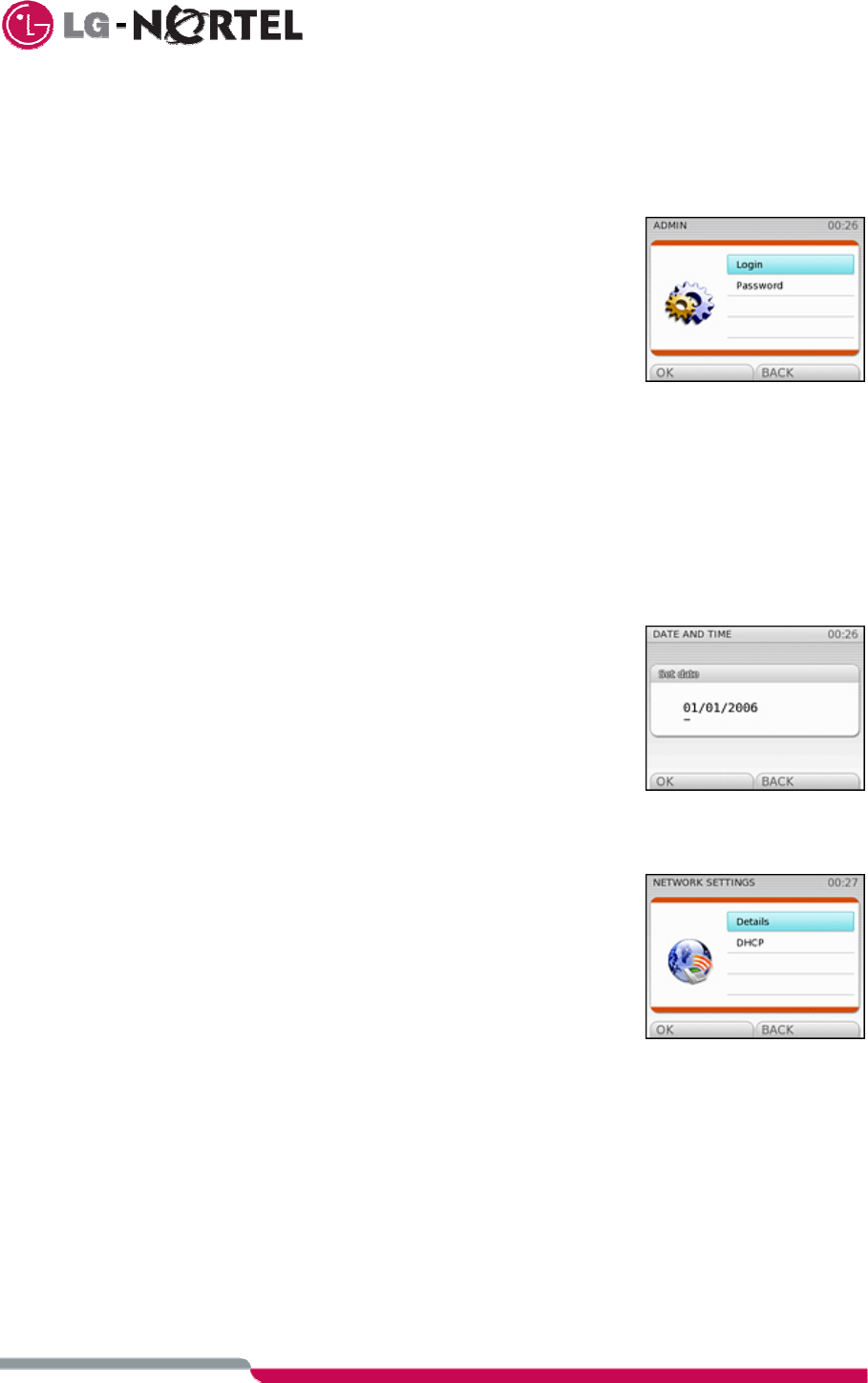
14
3.6.2 Admin mode
The IP PHONE 1535 includes an Admin mode, which is used to control access to several settings.
Settings for Camera mode, VoIP ports, Codec priority and database Reset can be accessed only if the
user logs in or activates the Admin mode.
To log in:
1. Select “main menu” → “settings” → “system settings” →
“admin” → “login”
2. Enter the PIN number (default = 0000) and Confirm with OK.
To log out:
• Select “main menu” → “settings” → “system settings” → “admin”
→ “logout”
To change the PIN (password):
1. Select “main menu” → “settings” → “system settings” → “admin” → “password”
2. Enter the old PIN (default = 0000) and press OK.
3. Enter the new PIN and press OK.
4. Confirm the new PIN and press OK.
3.6.3 Date and time
With this menu, you can modify the date and time. From the “system
settings” menu:
1. Select “date and time” and press OK.
2. Enter the date (MM/DD/YYYY) and press OK.
3. Enter the time (HH:MM) and press OK.
3.6.4 Network parameters
In this menu you can view or modify IP network parameters.
To access the Network parameters menu, from “main menu” → “settings” → “system settings”:
1. Select “LAN” or “WiFi” → “network settings” and press OK.
2. Select the desired option:
• Details: displays the current network configuration (MAC
address, DHCP, IP address, subnet mask, link port and DNS).
• DHCP: set DHCP or static IP Address.
• IP address: view/modify IP address.
• Subnet mask: view/modify the subnet mask.
• Gateway: view/modify the default Gateway address.
• DNS1/DNS2: view/modify the primary and secondary Domain Name Servers.
3. If you modify any of the above parameters, select “Apply”.
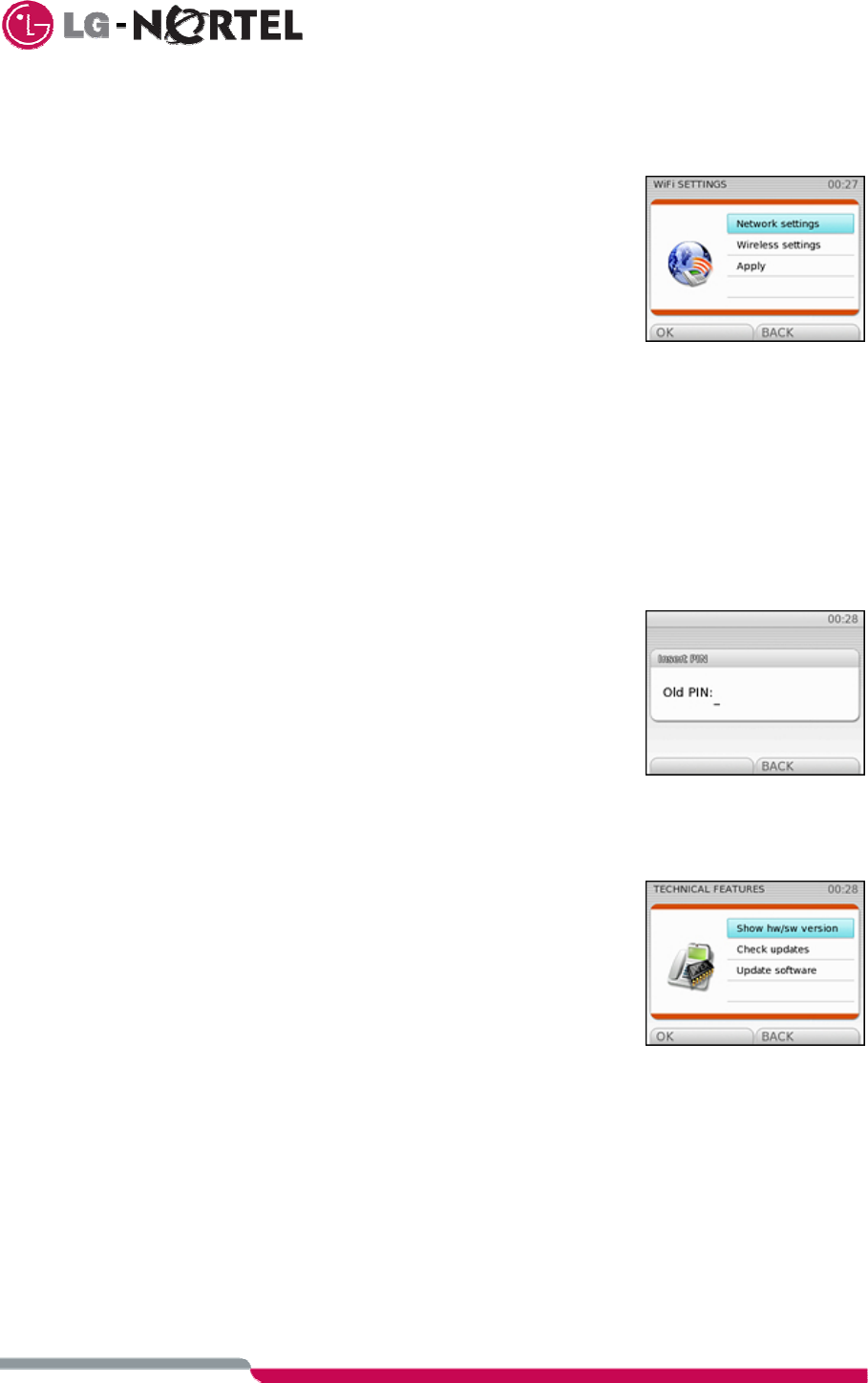
15
3.6.5 WiFi parameters
With this menu, you can modify WiFi interface parameters. From “main menu” → “settings” → “system
settings”:
1. Select “WiFi” and press OK.
2. Select the desired option:
• “Network settings”: provides information on the current
network configuration (MAC address, DHCP, IP address,
subnet mask, link port and DNS) and allows this data to be
modified.
• “Wireless settings”: enables you to choose from the following
options:
• Details: displays information regarding WiFi the current WiFi connection.
• WiFi scanning: scans to search for available WiFi networks.
• ESSID: view/modify your WiFi network’s ESSID, i.e. the code included in your WiFi
package identifying it as part of that network.
• Channel ID: view/modify the Videophone channel ID.
• Encryption: enable WEP type keying (64/128 bits).
• Authentication: the type of authentication is always WPA-PSK.
3. If you modify one of above parameters, select “Apply” to save the changes.
3.6.6 Modifying the system PIN
With this menu, you can modify the user PIN for features such as Video monitor, call restriction, etc. From
“main menu” → “settings” → “system settings”:
1. Select “pin” and press OK.
2. Enter the old PIN (default = 0000) and press OK.
3. Enter the new PIN and press OK.
4. Confirm the new PIN and press OK.
3.6.7 System Version Control
In this menu you can view the hardware and software version and check whether new updates are
available.
To access the Version Control Menu, from “main menu” → “settings” → “system settings”:
1. Select “technical features” and press OK.
2. Select the desired option:
• Show hw/sw version: displays hardware and software
version.
• Check updates: checks whether there are new updates
available for the equipment. This check can take several
minutes.
• Update software: updates the Videophone’s software. This
update can take several minutes.
3. Confirm with OK.

16
4 Voice Calls
The IP PHONE 1535 incorporates basic and advanced voice call handling functions. Calls can be placed,
received, held and transferred.
4.1 Placing a call
You can place a call by simply Dialing a number while the handset is off-hook or a number can be Dialed or
selected while:
• on-hook pre-dial, cell phone style
• from recall dial last number
• from Phonebook number from the phonebook
• from Call History number from Call Logs
The IP PHONE 1535 incorporates a full duplex Speakerphone, activated with the “Off-hook” key and Volume
and Mute control options are available, see section 4.3.
4.1.1 Pre-dial (Cell phone style)
Simply pre-dial the number before going off-hook, the number is displayed as each character is entered
from the dial pad. A character may be modified during pre-dial using the ”Delete” key. The “Options” key
allows access to several options such as “Save in Phonebook”. For these options, follow the on-screen
display instructions.
4.1.2 Recall Dialing
With this function you can automatically call the Last Number Dialed, simply select the Redial key to dial
the number in the normal or pre-dial mode.
4.1.3 Phonebook Dialing
In the Phonebook, see section 11, you may select from several options including to call a number from the
Phonebook. With this function you can make a call using a name in the Phonebook in the normal or
pre-dial mode.
To use phonebook to dial a number:
1. Select a Phonebook entry, see section 11.
2. Select the “Call” key or go off-hook (pick-up the handset or press the “Off-hook” button) to
activate the Speakerphone function.
4.1.4 Call Logs Dialing
In the Call Logs menu, “main menu” → “call history”, the user may select to call, store, or delete a
number, see section 8. With this function the numbers for each of the last 20 missed, Dialed, and
received calls is available for automatic Dialing.
1. Select the number to call and pick up the handset.
4.2 Incoming Calls
4.2.1 Receiving a Call
When an incoming call is received, the phone will alert you with the normal ring or, if the calling party is
identified as a VIP in the Phonebook and the VIP filter enabled, with the VIP ring signal assigned, see
section 11.

17
To answer the call, lift the handset or press the Off-Hook button to activate the Speakerphone function.
The phone displays the Caller Id or, if available in the Phonebook, the caller’s name and the caller’s
picture from the server.
4.2.2 Missed Call Notification/Return
When a call is not answered, the screen displays the Missed Calls message, informing the user of the
new missed call in the Missed Call Log. In this case, the Missed Call Log can be directly accessed with
the “View” key. To use the immediate “View” function, proceed as follows:
1. Select “View” from the left-hand side of the screen.
2. The Missed Call Log is displayed, starting with the most recent missed call.
3. Select “Options”, and “Voice Call” to return the missed call and press OK.
If CLI service (Calling Number Identification) is not available, the screen will display the Missed Calls
message however, no number is provided in the Missed Call Log display.
4.3 Active Call Options
During a conversation, select “Options” from the left-hand side of the screen, to access the following
functions:
4.3.1 Phonebook access
To access contacts saved in the phonebook, see section 11.
4.3.2 Mute the microphone
With this function you can disable the local microphone so as not to be heard by the remote party. To
activate microphone mute:
1. During the active call, select “Options” from the left side of the screen.
2. Select the “Mute” option using the vertical arrows.
3. Press OK to confirm and disconnect the microphone. The Mute icon (icon) will appear on the
screen.
To enable the microphone or deactivate Mute:
1. During a conversation select “Activate MIC” displayed in the right-hand side of the screen. The
Mute icon (icon) will disappear from the screen.
4.3.3 Audio volume
With this function you can modify, audio level for an active call in progress:
1. During conversation select “Options” from the left side of the screen.
2. Select “Audio volume” and press OK to Confirm. The screen will display the level currently in
use (levels from 1 to 5)
3. Using the vertical arrows modify the volume and confirm with OK.
4.3.4 Call hold
With this function, you can place a call in waiting state (Call Hold).
To activate call hold
1. During the conversation select “Options” from the left side of the screen.
2. Select “Call Hold” and press OK to confirm, the Call Hold icon (icon) will appear to indicate a
call is holding.

18
When you have an active call and a call on Hold, selecting Call Hold will place the active call on Hold and
connect the Holding call. In this way, you may toggle between the Holding and active call, which is known
as a “Brokers Call”.
To return to the holding call:
1. Select “Resume” and the holding call is connected.
4.3.5 Blind transfer
With this function, you can send the active call to a 3rd party directly without first speaking with the
receiving party.
To Transfer a call:
1. During the conversation select “Options” from the left side of the screen.
2. Select “Blind Transfer” and confirm with OK.
3. Dial the number you wish to receive the transfer and confirm with “Call”, the “Call transfer
complete” message is displayed and theIP PHONE 1535 returns to idle.
4.3.6 Consultation transfer
With this function, you can place a call to a 3rd party and send the original call to that party.
1. During the conversation select “Options” from the left side of the screen.
2. Select “Consultation Transfer” and confirm with OK.
3. Dial the number and confirm with “Call” to make a second call.
4. After the call is connected, select “Transfer”, you and the two remote parties are connected in
an active call.
5. Hang-up to complete the transfer and return to idle.
4.3.7 Conference
With this function, you can establish an ad-hoc conference call.
1. During the conversation select “Options” from the left side of the screen.
2. Select “Conference” and confirm with OK.
3. Dial the number and confirm with “Call”.
4. After the call is connected, select “Conference”, you and the two remote parties are connected
in an active call. If the conference initiator hangs up, the conference is terminated and all
parties are disconnected.
4.3.8 Show hw/sw Version
Selecting “hw/sw version” from the “Options” menu will display the revision associated with the IP PHONE
1535 hardware and software.
4.3.9 Telephone number
Selecting “Telephone Number” from the “Options” menu will display the Phone number associated with
the IP PHONE 1535.

19
5 Video Calls
The IP PHONE 1535 incorporates Videophone capability, the ability to transmit and receive video.
5.1 Making a Video Call
You can establish a video call in two ways, a direct Video call or an indirect Video call where a voice call is
switched to a video call.
5.1.1 Direct Video Call
To make a direct Video call, use one of the following procedures:
1. From idle, dial the number you wish to call and press the video button.
Or, alternatively,
1. Press the Video Call button,
2. Dial the desired number,
3. Press the Video Call button, Off-hook button or wait about 5 seconds and the call is placed
automatically.
As with a voice call, Video calls can be placed using Recall, the Phonebook and the Call Logs, see
section 4.1.
5.1.2 Indirect call
To make an indirect Video Call:
1. Place a Voice call,
2. Request a Video call by pressing the Video Call button. Your screen will display the message:
“Your Video call request is being processed” and the remote party receives the message:
“Video call requested. Please accept or reject the video call”.
3. The remote user must press the Video Call button to accept the request.
Important: only the initiator of a voice call can request an indirect Video Call.
5.2 Receiving a Video Call
When an incoming video call is received, the user can accept the call in one of several ways:
1. If the user accepts the call by pressing Off-hook button or lifting the handset, the Video call will be
established. The accepting user (called party) will receive video but must press the Video button
to transmit video to the caller.
2. If the user accepts the call by pressing the Video button, video is transmitted and received by both
parties.
5.3 Video Call Controls
5.3.1 Video Privacy (Mute)
If you press the Video Mute button, the phone stops sending the video image to the remote party. Press
the Video Mute button once more, to restart video transmission. The change is only effective for the
current call.
5.3.2 Video Window Size
With this function, you can set the display size of the video call. The screen sizes available are:
• Full remote screen: the remote image is displayed full-screen.
• Large remote/small local: the remote image is displayed large, while your own image is seen in a
small frame.

20
• Small remote and local: both local and remote images are displayed in a small frame.
5.4 Active Video Call Options
During a Video Call a number of options are available as explained below. These options are selected from
the “Options” menu. In addition, the received Video can be captured as a photo or video and stored in the IP
PHONE 1535 Image gallery, see section 9.
5.4.1 Show/hide Details
This option may be used to display or hide information relating to the Video call. The following information
is displayed:
• Number: indicates telephone number or name of the remote user, CLI service is required.
• Status: indicates the current status of the call.
• Audio volume: indicates the current audio volume level.
• Video fluency: indicates the user setting for video fluency
• Frame rate: indicates the number of video frames per second sent.
5.4.2 Video fluency
With this function you can set the image fluency level (choosing from five different values) during a video
call. Modifying this parameter allows you to increase or decrease the fluidity of the image transmitted
during a video call. This parameter is also determined by the definition with which the image is sent. In
fact, the greater the reproduction speed (fluency), the lower the image quality.
5.4.3 Phonebook
To access contacts saved in the Phonebook, see section 11.
5.4.4 Mute the Microphone
With this option, you can disable connecting the local microphone so as not to be heard by your remote
party, see section 4.3.2.
5.4.5 Audio Volume
With this option, you can adjust the current audio level, see section 4.3.3.
5.4.6 Show hw/sw version
With this option, you can display the current hardware and firmware version.
5.4.7 Telephone number
Selecting “Telephone Number” from the “Options” menu will display the Phone number associated with
the IP PHONE 1535.
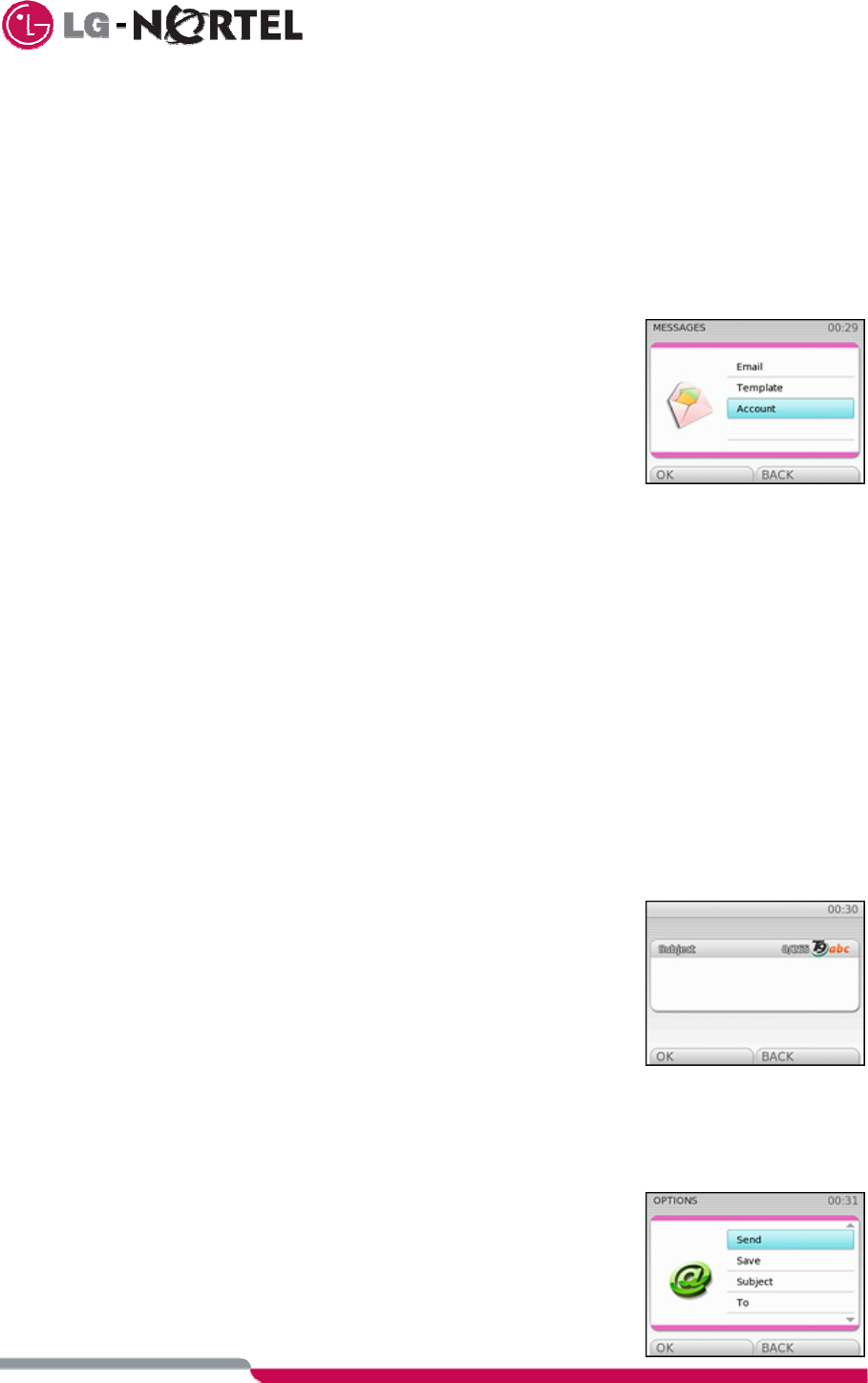
21
6 E-Mail Messages Menu
If you have subscribed to E-Mail Service, you can access E-Mail through the “Messages” menu.
6.1 Configuring E-Mail
Before using the E-mail service, you must configure your account. E-Mail service is configured through the
“Messages” menu:
1. From idle, select “main menu” → “messages” and confirm with OK.
2. Select “account” and Confirm with OK.
3. Select “add new” or “modify” and Confirm with OK.
4. Enter the parameters of your account:
• SMTP server address
• Receiving Protocol, POP or IMAP server
• POP Server address
• IMAP Server address
• User/account
• User Information, User Name and E-Mail address.
5. Select OK to confirm an entry.
6.2 E-mail Menu Options
From the “E-mail” menu, selections are available to “Write” and access saved or “Draft” e-mails.
6.2.1 Writing an email
Under the “Write” menu, you can write, send and save an E-Mail as well as enter the receivers and attach
files to an e-mail. Based on your subscription, the number of characters, receivers, etc. may be limited.
To prepare an E-Mail:
1. From the "e-mail" menu select "write" and confirm with OK.
2. Select and enter the “subject” (maximum 255 characters).
3. Enter the text of the email. At this point you can move between the different words using the
vertical and horizontal arrows, either to insert a new word or to delete it by pressing the
on-screen “Delete" key.
4. At any time, you may select an item from the “Options“ menu as below:
• Send: to send the e-mail
• Save: to save the email created in Draft box.
• Subject: to add or modify the subject of the email.
• To: to add an email address of the desired recipient.
• Cc: to send a carbon copy to the desired recipients.
• Bcc: to send a blind carbon copy to the desired recipients.
• Attachment: to attach images, sounds or videos from
SD/MMC.
• Insert template: to insert a sentence from pre-selected list.
Recipients can be entered from the dial pad or can be selected from the “Phonebook”.
6.2.2 Sending & Saving an E-Mail
Once you have finished preparing an E-Mail message, you may send and/or
save it from the “Options” menu selections:
To send or save an active E-Mail
1. From the “write” or “draft” menu select “Options”
2. Select "Send” or “Save” and confirm with OK.
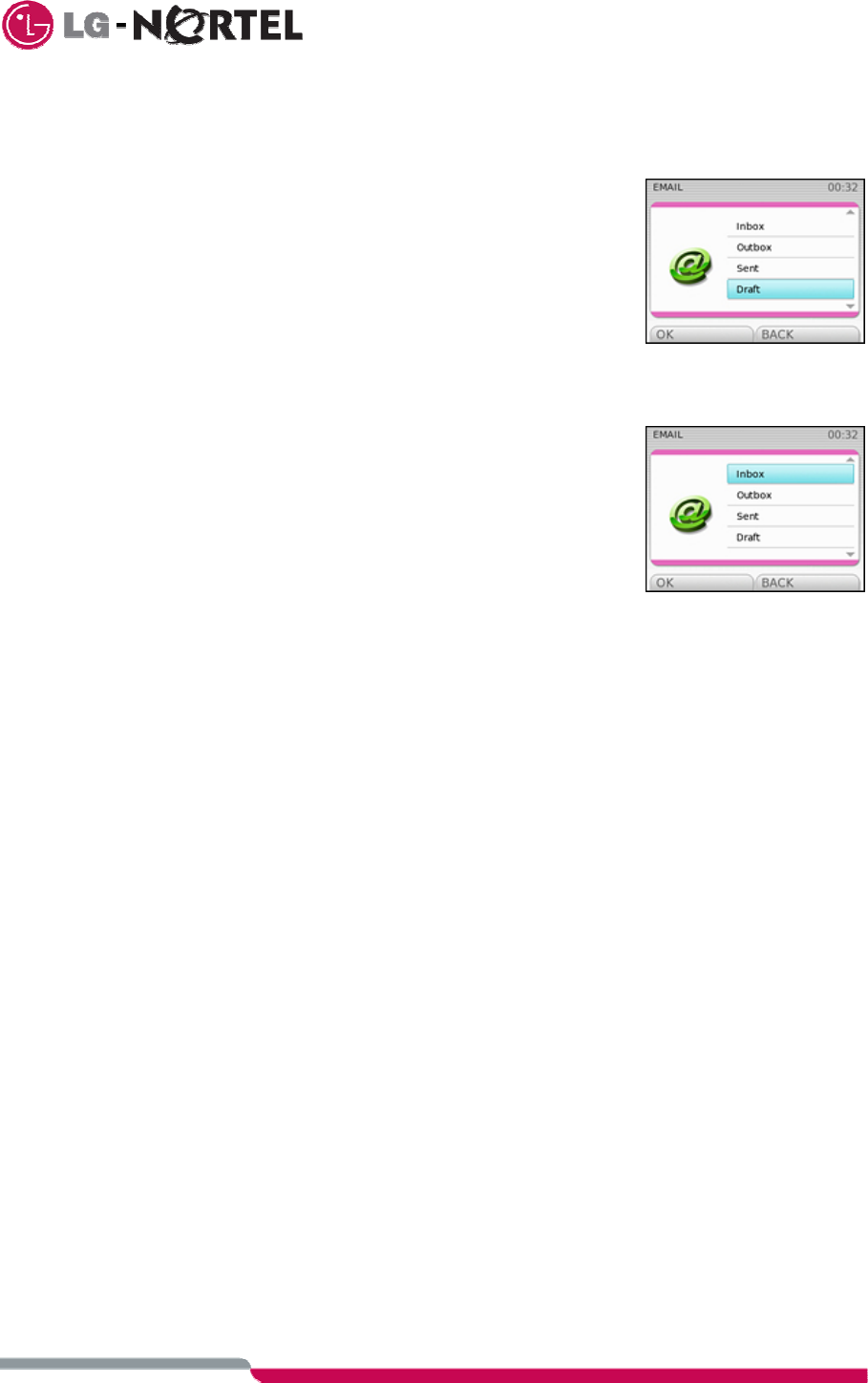
22
You may also select a saved E-Mail to send by entering the “Subject” of the E-Mail before step 2 above
and then selecting “Send” to send the email.
6.3 Accessing saved E-Mails
To recover an E-Mail you have saved in your “Draft” box:
1. From the "e-mail” menu, select “draft”.
2. Select the desired E-Mail using the vertical arrows, and accept
with OK.
6.4 Reading New E-Mails
Upon receipt of a new email, your Videophone screen displays the “New Mail” icon (icon). To read a
received E-Mail:
1. Select “inbox” from the left-hand side of the screen. The content is
displayed, and you can move through it using the vertical arrows. If
you do not wish to view at this time, select “Exit” located in the
right-hand side of the screen.
Received E-Mails may also be reviewed from the “E-Mail” menu by selecting
“Read” and selecting the subject.
6.5 E-Mail Management Options
Received and saved E-Mail messages can be deleted, forwarded, edited, etc. When you open a received
(“Read”) or saved (‘Draft”) E-Mail you can access a series of options to manage your E-Mails. Options
available are:
• Delete: to delete an E-Mail.
• Forward: to forward the email to another recipient.
• Edit: to edit the text of the email before resending.
• Details: to view information on the E-Mail (address/date/time).
After selecting the deisr1ed option, you can delete, forward or edit the E-Mail. Selecting details displays the
date/time stamp for the mail as well as sender/receiver identification.
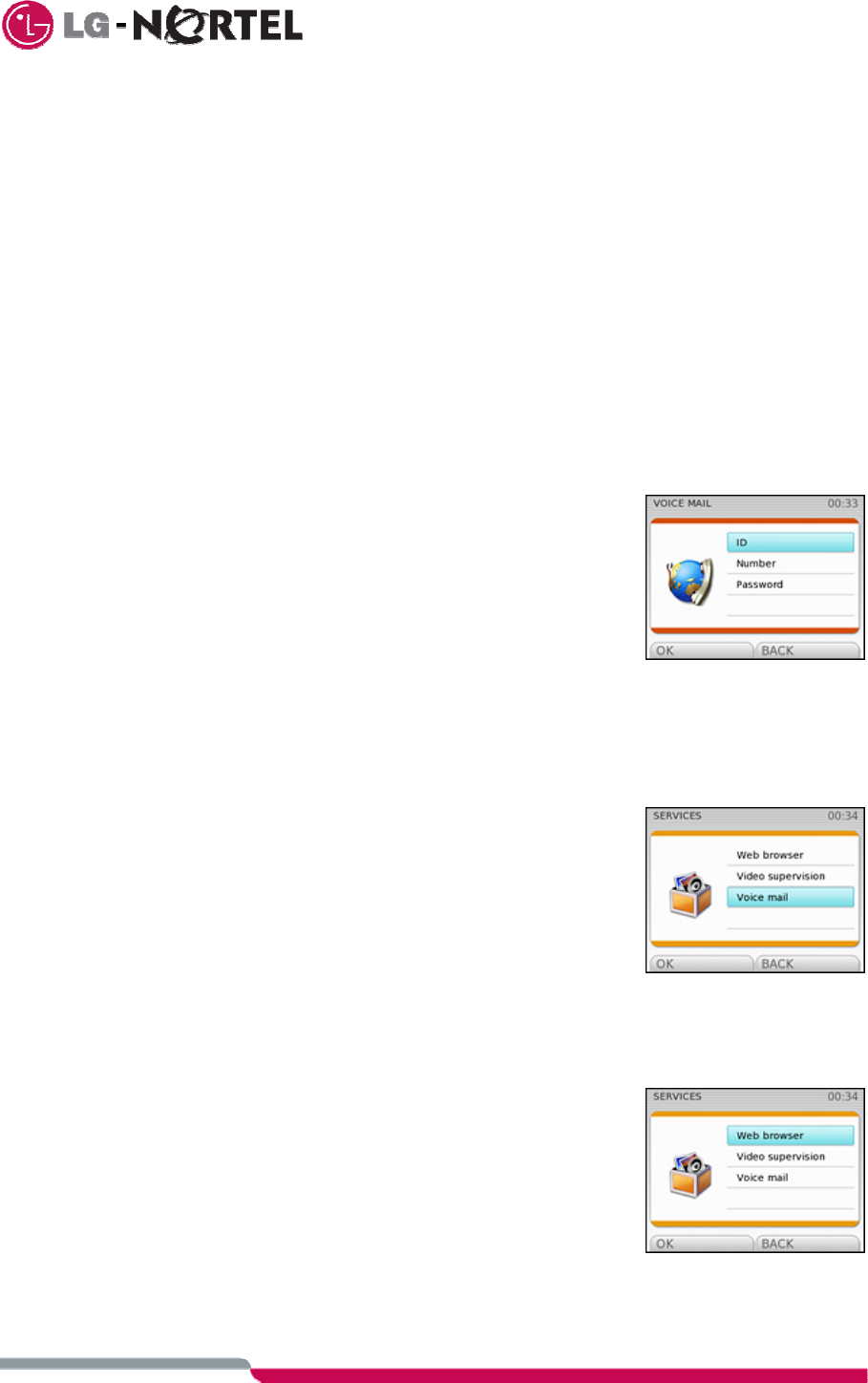
23
7 Services Menu
Your Service provider may provide advanced services, which are accessed in the “Services“ Menu. From the
“Services Menu” you can manage your Voice Mai-box, browse the Web and control Video Monitoring services.
7.1 Voice Mail
If you have subscribed to Voice Mail Service, you can access Voice Mail through the “Services” menu. Prior
to accessing your Voice Mail some configuration, as described below, may be requires.
7.1.1 Configuring Voice Mail
Before using the Voice Mail service, you must configure you Voice Mail-box. You will need to configure
your Voice Mail-box number. Also, for simplified access, your User Id and password may be configured in
IP PHONE 1535 so that the Id and password are automatically sent when you access the Voice Mail
service.
To configure the Voice Mail-box Number, from “main menu” → “settings” → “VoIP settings:
1. Select “number”.
2. Enter the number associated with your Voice Mail-box.
To configure the Voice Mail-box id “main menu” → “settings” → “VoIP
settings:
1. Select “id”.
2. Enter the Id for your Voice Mail-box.
To configure the Voice Mail-box password, from “main menu” → “settings” → “VoIP settings:
1. Select → “password”.
2. Enter your Voice Mail-box password.
7.1.2 Accessing Voice Mail
Once configured, access your Voice Mail-box using the “Voice Mail”
selection in the IP PHONE 1535 “Services” menu, “main menu” →
“services” → “voice mail”. After access to your Voice Mail-box follow the
audio menus to manage (listen to, save, delete, etc.) your voice mails.
7.2 Web browser
The IP PHONE 1535 software includes a Web browser designed to function with your Service Providers
network. With the browser, you can browse the Web or select from one of four (4) favourite sites. For the
Web browsing function, a broadband connection and Profile, see section 3.1 must be available.
The browser can be accessed from:
1. The Main Menu, “maim menu” → “services” → “web browser”
2. The Web icon (icon).
Both methods provide access to a list of favourites (maximum 4) or a URL
(Web page) entry screen.
To access the Web from the “web browser” menu:
1. Select one of the Favorites or select “web menu” and confirm with OK. If you selected a favorite,
the web page is displayed.
2. From the “web menu”, select Write URL and confirm with OK

24
3. Use the dial pad to enter a URL and confirm with OK to display the Web page.
The IP PHONE 1535 will display a quarter of the Web page; use the navigation button to move through the
page.
7.3 Video Monitoring
The Video supervision facility permits you to monitor the camera of a remote Videophone/camera from
pre-assigned Videophones.
The Videophone/camera to be monitored must be enabled and monitoring Videophone numbers must be
registered with the Videophone to be monitored. To configure the Video Monitoring service at the
Videophone to be monitored, from “main menu” → “services” menu:
1. Select “Video Supervision” and press OK.
2. Enter the PIN number (default = 0000) and Confirm with OK. This
PIN is requested when you attempt to activate Video Monitoring.
• Enable/Disable: to activate or deactivate the service.
• Number: the telephone numbers allowed monitoring the camera (up
to 3 telephone numbers).
3. Select “Enable” or “Disable” and confirm with OK,
Or
4. Select “Number” and confirm with OK
5. Enter the number of the Videophone used as the monitor. Up to three Videophone numbers can
be entered as monitors.
After you have configured Video Supervision, the Video Supervision icon (icon) will appear on the main
screen.
To activate the monitor function:
1. From one of the monitoring Videophones registered in step 5.
above, call the Videophone to be monitored.
2. Enter the PIN as in step 2, above.
3. Press the Monitor key.
You will be able to view images from the Videophone where Video Monitor
service has been configured.
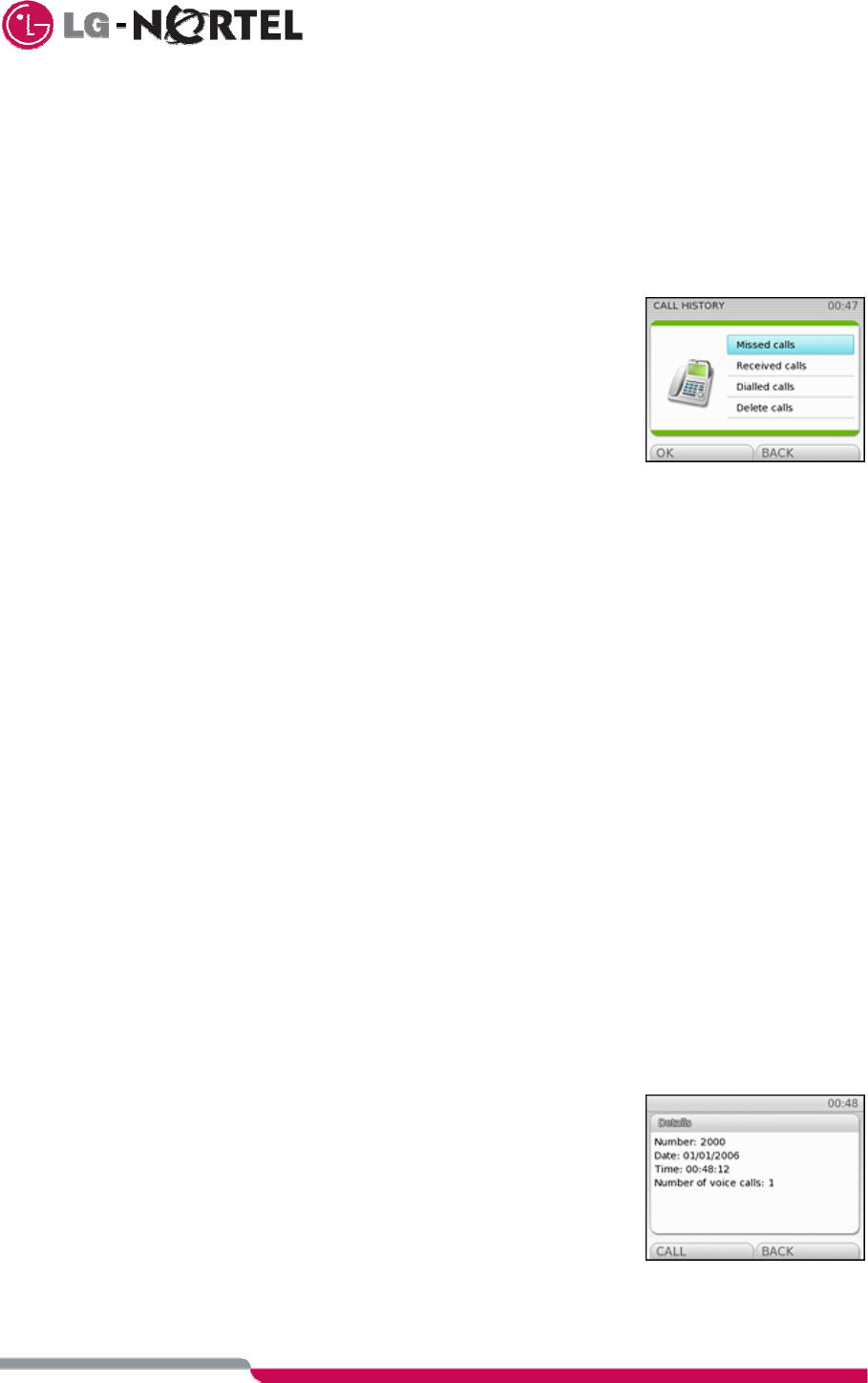
25
8 Call History
The Call History stores, in three different directories, the last 20 calls missed, received and Dialed.
The information on the missed and received calls is available only to customers who subscribe to the CLI
(Calling Line Identification) service. If CLI service is not available, only “Number reserved” will be displayed.
8.1 Viewing Call Logs
To access the Call Logs:
1. With the Videophone idle, select “main menu” → “call history”.
2. Select an option from the “Call History” menu:
• Missed calls: contains information on the last 20 unanswered calls.
• Received calls: contains information on the last 20 received calls.
• Dialed calls: contains information on the last 20 dialed calls.
• Delete calls: delete call records from all or a selected Call Log, see
section 8.3.
3. Select the list you wish to consult (missed/received/dialed) and press OK to confirm.
The screen will display the numbers from the selected Call Log. If the number matches an entry in the
Phonebook, the corresponding name will be displayed in place of the number.
To access the options relating to the missed/received/Dialed call, select “Options” from the left-hand side of
the screen.
8.2 Call Log Options
Once you have selected a record from one of the Call Logs, several options can be accessed with the
“Options” key as follows:
• Details: details for the call including number, date, time and duration.
• Save in Phonebook: to save a selected record to the Phonebook
• Delete: delete a selected record.
• Send SMS:
• Send MMS:
• Voice call: place a voice call to the telephone number.
• Video call: place a video call to the telephone number.
8.2.1 Details
With this function you can view details on the selected call. To use this function from “main menu” →
“call history”:
1. Select the desired Call Log (missed/received/Dialed).and confirm with OK,
2. Select the desired call record,
3. Select “Options”,
4. Select the “Details” option and press OK.
The details on the selected call will appear on the screen:
• Telephone number
• Date and Time of the call
• Call duration (only for dialed and received calls)
8.2.2 Saving in the Phonebook
With this function you can save the telephone number from a selected record to the Phonebook. To use
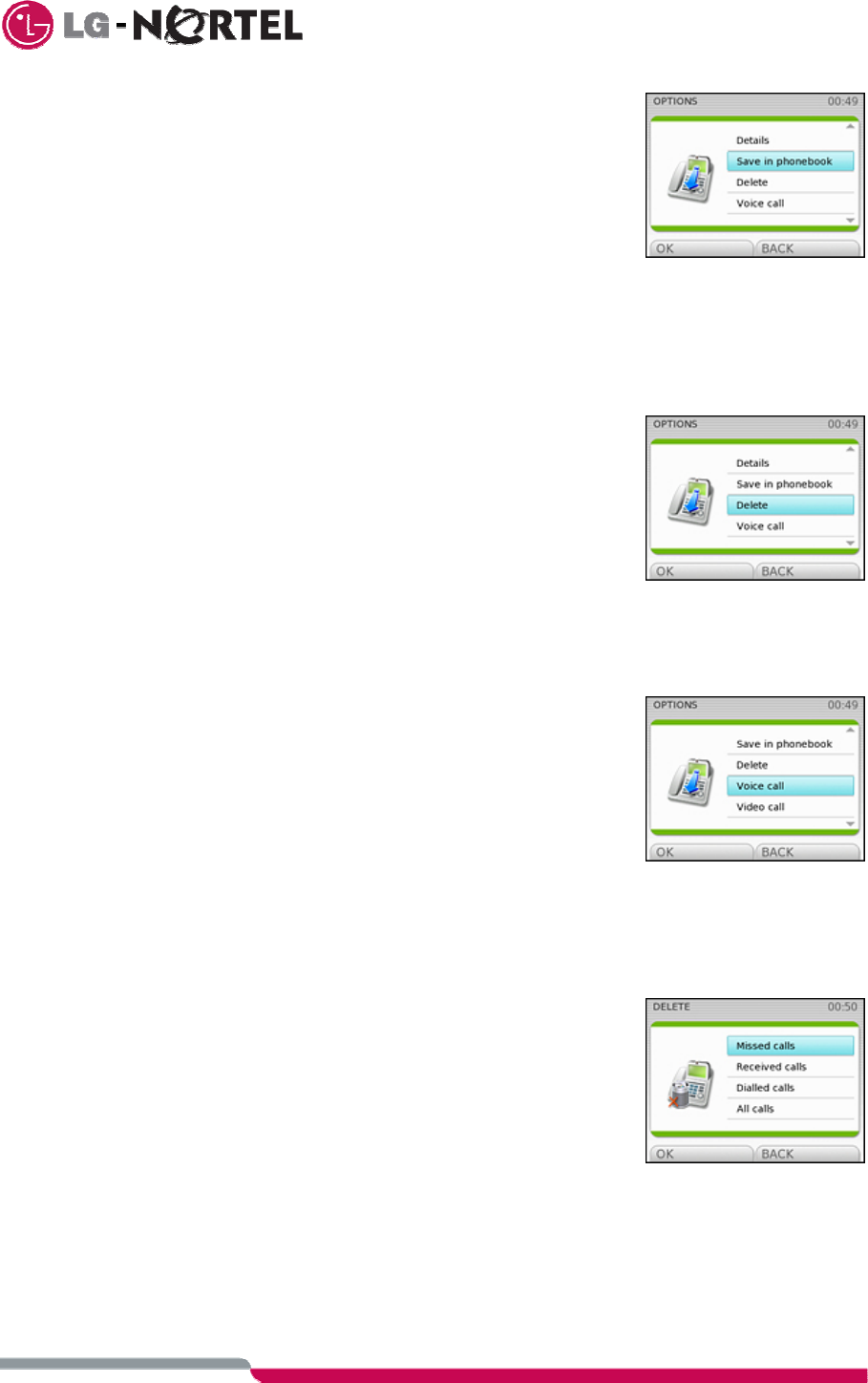
26
this function from “main menu” → “call history”:
1. Select the desired Call Log (missed/received/Dialed).and
confirm with OK,
2. Select the desired call record,
3. Select “Options”.
4. Select “Save in Phonebook” option and press OK.
5. Enter the name associated with the telephone number selected.
Note: with this operation you can only associate the contact name with the number; you must access the
Phonebook directly to edit other information such as E-Mail address.
8.2.3 Delete a Call Record
With this function you can delete a call record in the selected Call Log. To use this function, from “main
menu” → “call history”:
1. Select the desired Call Log (missed/received/Dialed).and
confirm with OK,
2. Select the desired call record,
3. Select “Options”,
4. Select the “Delete” option and press OK.
5. Press “YES” to confirm or “NO” to cancel.
8.2.4 Call
With this function, you can call the telephone number from a selected Call Record. To use this function
from “main menu” → “call history”:
1. Select the desired Call Log (missed/received/Dialed).and
confirm with OK,
2. Select the desired call record,
3. Select “Options” to access the options relating to the selected
record.
4. Select the “Call” option and press OK.
At this point the Videophone will dial the number selected and start the call
in Speakerphone mode.
8.3 Deleting Call History Logs
With this function you can delete all the call records in the call history or in an individual Call Log. To use this
function from “main menu” → “call history”:
1. Select the “Delete calls” option and press OK.
2. Select one of the following options and confirm with OK:
• Missed calls: to delete all missed call records.
• Received calls: to delete all received call records.
• Dialed calls: to delete all dialed call records.
• All calls: to delete all call records.
3. Select “YES” to delete or “NO” to cancel and return to the main
menu.
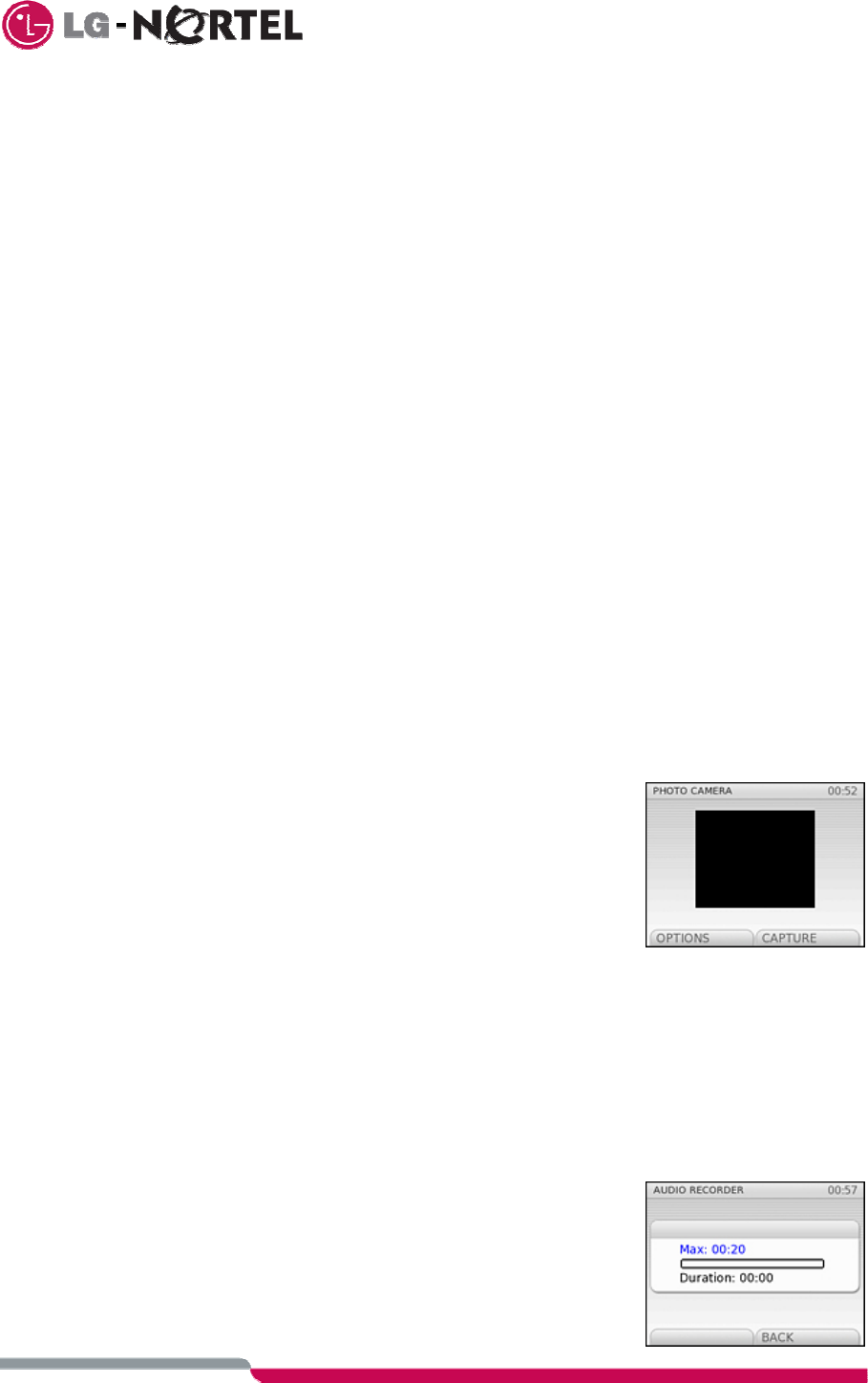
27
9 Images and Sounds
The IP PHONE 1535 includes several galleries for sounds, photos and videos. Various galleries are provided
to allow the user to separate the different file types in the different galleries. The audios (sound) gallery
includes fifty (50) pre-stored sounds in the Videophone gallery. An additional sixty (60) audios can be stored
by the user, twenty (20) each in the Recorded Audios, Received and Other Melodies galleries. The stored
audio files may be used as normal ring tones or assigned to a contact in the Phonebook and used as VIP ring
tones, see section 9.2.
The photo gallery includes five pre-stored pictures and 60 images can be captured with the camera, see
section 9.1, or stored from an SD/MMC card, see section 13. These pictures can be assigned as the
Videophone background screen or assigned to a contact in the Phonebook, which is displayed when a call is
received from the contact. These pictures can also be sent as an attachment to an E-Mail, see section 6.
Two additional Video galleries, Recorded and Received Video galleries, can be used to store up to twenty (20)
short Video clips each for a maximum of forty videos, see section 9.3. These video clips can be sent as an
attachment to an E-Mail, see section 6.
9.1 Image Galleries
The Image galleries contain sixty-five (65) images permanently stored in the IP PHONE 1535 memory or
stored by the user. The user can capture and store photos taken by the KVP-2890 camera (up to 20). Also,
up to forty (40) images can be copied from an SD/MMC card, see section 13, to the Received Images
galleries, twenty each in the Wallpaper and Pictures sub-galleries.
9.1.1 Taking Photos
With your Videophone you can take photos and save up to twenty (20) in the Photo gallery. The
procedure for taking a photo is as follows:
1. From idle select “main menu” → “images and sounds” → “images” → “taken photos”.
2. Select “New” and confirm with OK
• Capture: to capture the on-screen image and save or to delete
the photo.
• Options: two options are available:
• Camera timer: delays the capture of an image by 10
seconds.
• Quality: selects the image quality (high or low).
If you save a photo, you can view it at any time from: “main menu” → “images and sounds” → “images”
→ “taken photos” → “photo gallery”.
9.1.2 Administrating images
The IP PHONE 1535 Videophone Image gallery contains five (5) pre-stored images and space for
additional twenty (20) photos captured from the Videophone camera or forty (40) stored from an SD/MMC
card. The images can be used as the Videophone background screen or sent as an attachment to an
E-Mail. In addition, captured images or images stored from an SD/MMC card can be assigned as a
Contact’s image and displayed when a call is received from the contact.
To access the image gallery, proceed as follows:
1. From idle select “main menu” → “images and sounds” →
“images”.
2. Select the desired Image Gallery as below:
• Taken Photo, photos using the Videophone camera.
• Videophone images, pre-stored images
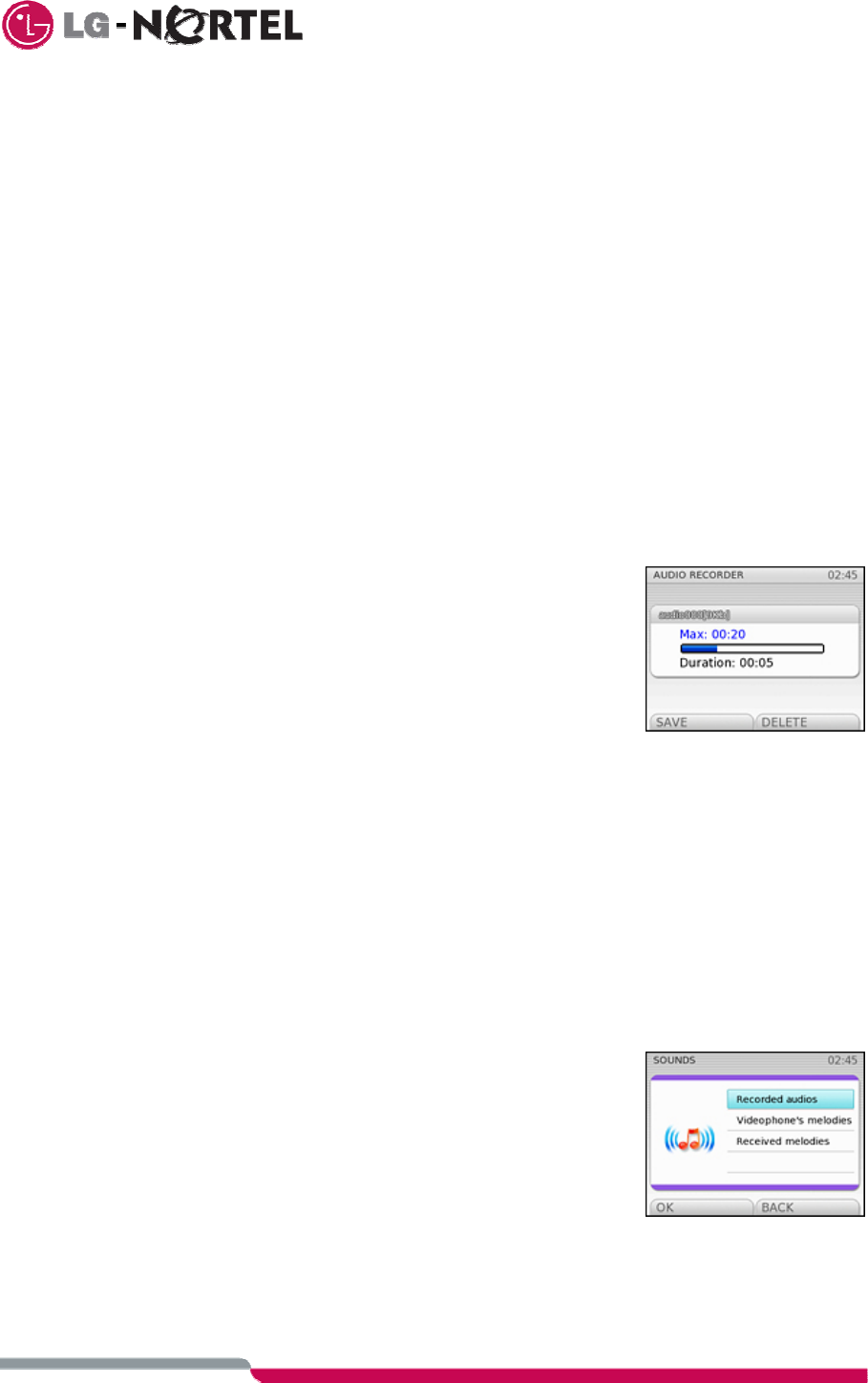
28
• Received images, images stored from an SD/MMC card.
3. Select the desired image.
4. To access the available options, select “Options” from the left-hand side of the screen. The
screen will display the options menu as below::
• Set as background: to establish the selected image as the background.
• Delete: to eliminate the selected image. Not available in Videophone Images.
• Rename: to change the name of the file containing the selected photo. Not available in
Videophone’s images.
• Assign to a contact: to assign the image to a person in the phone book. When you receive a
call from this person, the associated image will be displayed. Not available in Videophone’s
images.
• Sort: to order gallery images by name or size.
• Details: to view the details of the selected image (name, date, file size, photo size).
5. Select the desired option and follow the on-screen directions.
9.2 Sound Galleries
9.2.1 Recording Audio
With your Videophone you can record sounds up to 20 seconds long and save them in the Recorded
Audio gallery. Up to twenty (20) sounds can be recorded and stored in the Recorded Audio gallery. The
recording procedure is as follows:
1. From idle select “main menu” → “images and sounds” →
“sounds” → “recorded audios” → “new”.
2. To start recording, select “Record” and record the desired audio.
3. Select “Stop” to stop recording, at which time you have two
options:
• Save: to save the recorded audio.
• Delete: to remove the audio you have just recorded.
4. Select the desired option and confirm with OK.
If you save a recorded audio, you can listen to it at any time from: “main menu” → “images and sounds”
→ “sounds” → “recorded audios” → “Audio gallery”.
9.2.2 Administrating sounds
The Videophone has several sound galleries. The Videophone Melodies gallery includes fifty (50)
pre-stored melodies. The Recorded Audio gallery contains up to 20 sounds recorded by the user. The
Received Melodies gallery with up to forty (40) sounds copied from an SD/MMC card in two sub-galleries
(Polyphonic & Other).
To access a gallery proceed as follows:
1. With the telephone idle, select “main menu” → “images and sounds” → “sounds. The
screen will display the different audio galleries available.
• Audio
• Videophone Melodies
• Received Melodies, Polyphonic
• Received Melodies, Other
2. Select the desired gallery.
3. Select the desired sound file.
4. To access the options available, select “Options” from the
left-hand side of the screen. The screen will display the options menu:
• Set as ringing: to establish the selected audio as the ring tone.
• Delete: to remove the selected audio. Option not available in Videophone’s melodies.
• Rename: to change the name of the file containing the selected audio. Option not available in
Videophone’s melodies.
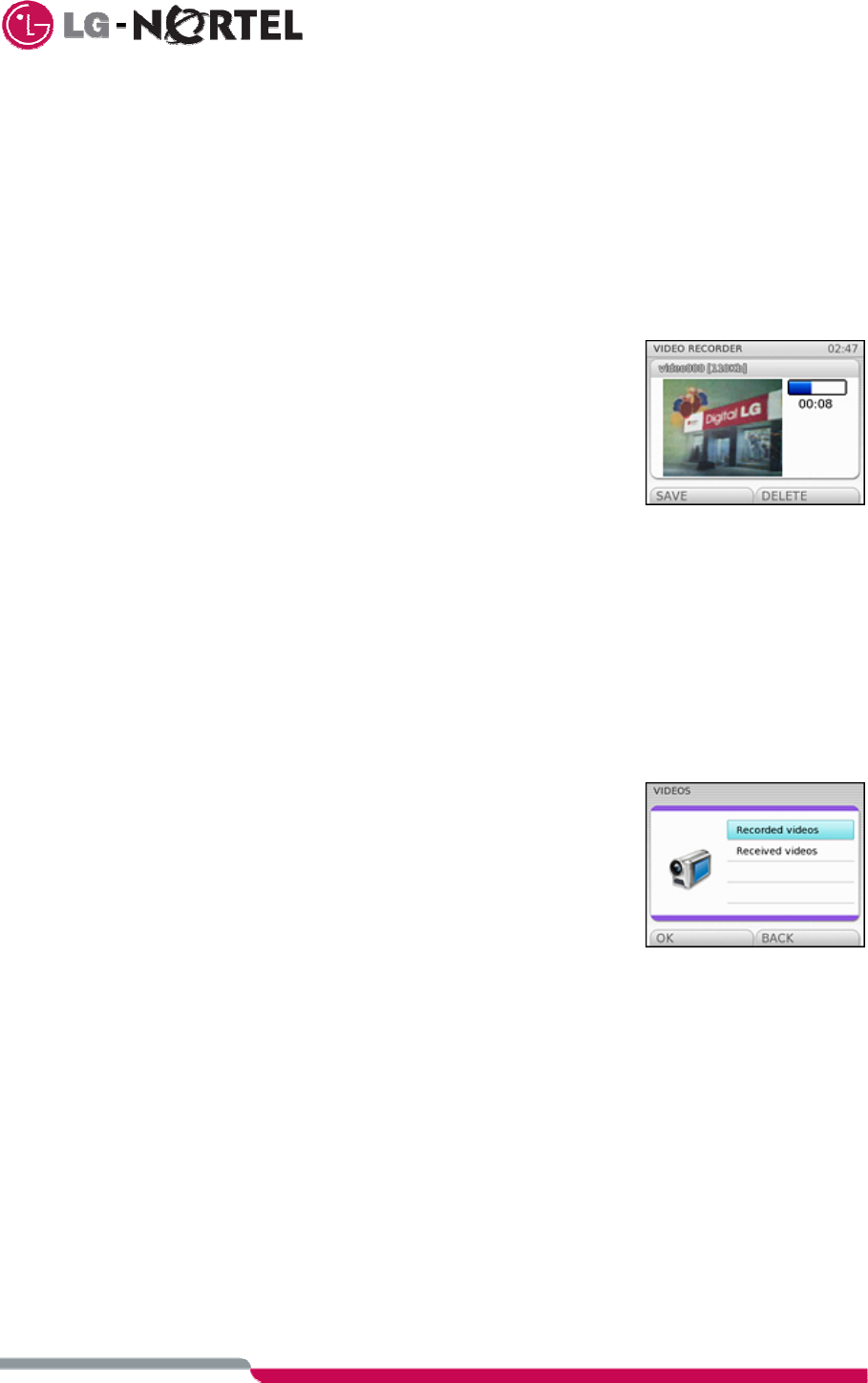
29
• Assign to contact: to assign the audio to a person in the phonebook, so that when a call is
received from the contact, the associated audio is provided as ring.
• Sort: to order the audios in the gallery by name or size.
• Details: to view the details of the selected audio (name, date, file size).
9.3 Video Gallery
9.3.1 Recording Videos
With your Videophone you can record up to twenty (20) sort video clips using the IP PHONE 1535 camera
and save them in Video gallery.
The recording procedure is as follows:
1. From idle select “main menu” → “images and sounds” →
“videos” → “recorded videos” → “new”.
2. To start recording select “Record” and the camera’s output is
record as video.
3. Select “Stop” to stop recording, you have two options:
• Save: to save the recorded video.
• Delete: to remove the video you have just recorded.
If you save a recorded video, you can recover it at any time from: ““main menu” → “images and sounds”
→ “videos” → “recorded videos” → “video gallery”.
9.3.2 Administrating videos
The IP PHONE 1535 has several Video galleries including the Recorded Videos, videos recorded with the
Videophones camera, and the Received Videos gallery, containing up to twenty (20) videos stored from
an SD/MMC card.
To access the gallery proceed as follows:
1. With the Videophone idle, select “main menu” → “images and sounds” → “videos”. The
screen will display the various video galleries available
• Recorded Videos
• Received Videos
2. Select the desired gallery.
3. Select the desired Video file.
4. To access the available options select “Options” from the
left-hand side of the screen. The screen will display the options
menu composed of the following elements:
• Play: to view the selected video.
• Delete: to eliminate the selected video.
• Rename: to change the name of the file containing the selected video.
• Sort: to order the videos of the gallery by name, size or date.
• Details: to the see the details of the selected video (name, date, file size).
5. Select the desired option and follow the on-screen instructions
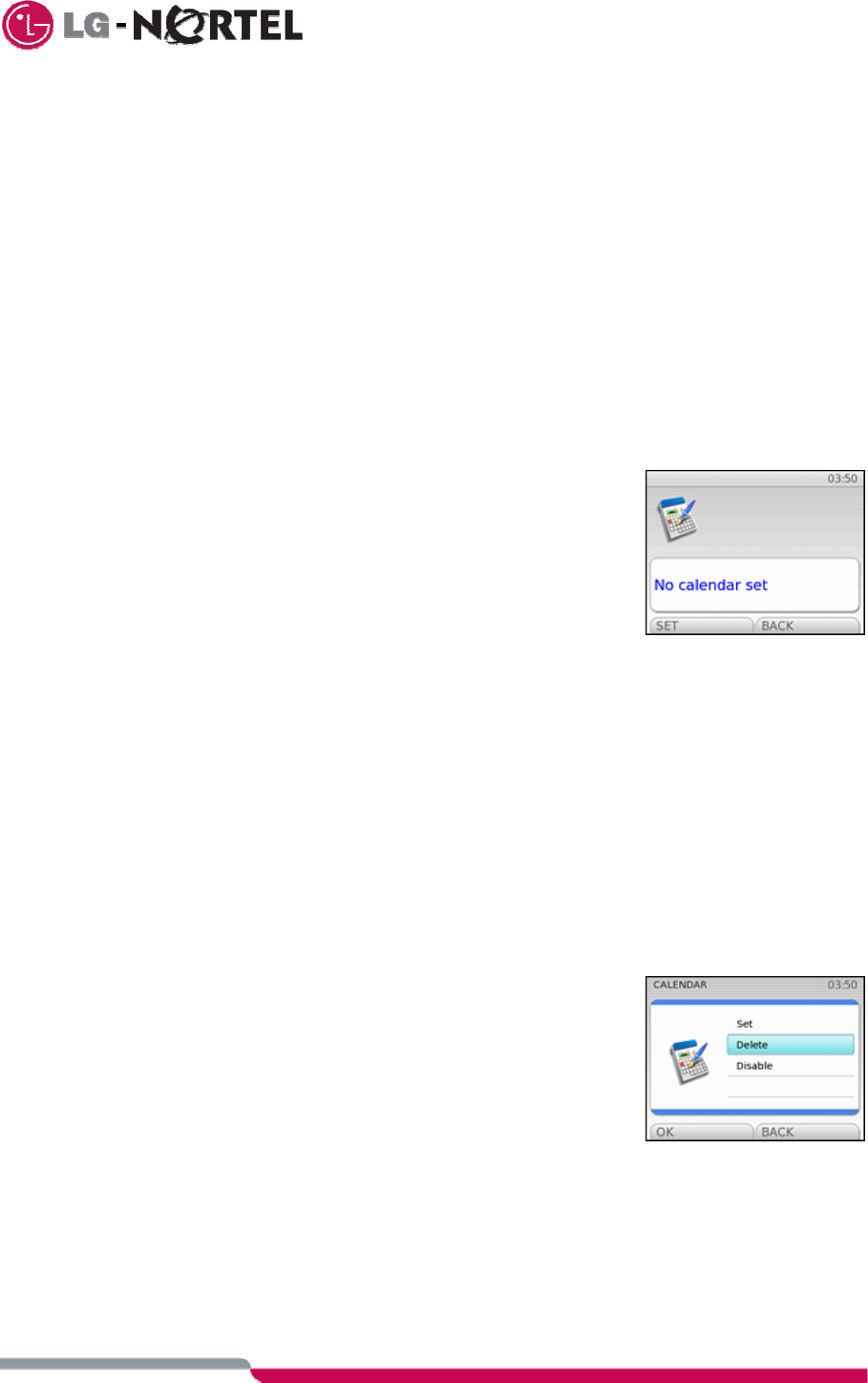
30
10 Calendar
The Videophone has the alarm function that can be set to notify the user with a display message at an
assigned date and time. To set the alarm function:
1. Select “main menu” → “organizer” → “calendar”.
2. If there is no alarm programmed, the screen will display a message informing you of this and you
will have the option to program an alarm with “Set”.
3. If there is already an alarm set, you will have the following options:
• Set: to add a new alarm to your calendar (date, time and text).
• Delete: to remove a programmed alarm.
• Enable/Disable: to activate/deactivate the alarm function.
10.1 Creating a new alarm
To create a new alarm, from “main menu” → “organizer” → “calendar” proceed as follows:
1. Select the “set” option using the vertical arrows and press OK to confirm.
2. With the telephone dial pad, enter the date (day/month/year)
desired for the alarm to display. You can move through the
characters with the horizontal arrows to make corrections.
3. Press OK to confirm.
4. With the telephone dial pad, enter the time (minutes: seconds) for
the alarm notification to display. You can move through the
characters with the horizontal arrows to make corrections.
5. Press OK to confirm.
6. Enter a text of the message (maximum, 40 characters) to display and press OK to confirm.
Once the alarm has been created, in idle mode, the screen will display the alarm icon (icon).
10.2 Options available
At the assigned date and time, the alarm will sound and the screen will display the text entered in the alarm.
At this point, you have two options:
• Select “Snooze” from the left-hand side of the screen to receive the alarm again in 5 minutes.
• Select “Disable” from the right-hand side of the screen to deactivate the alarm.
10.3 Deleting an Alarm
To delete an alarm from the Calendar:
1. Select “main menu” → “organizer” → “calendar”.
2. Press OK to confirm.
3. The screen will display a request to confirm the deletion. To
confirm press “YES”, or press “NO” to cancel the deletion
procedure.
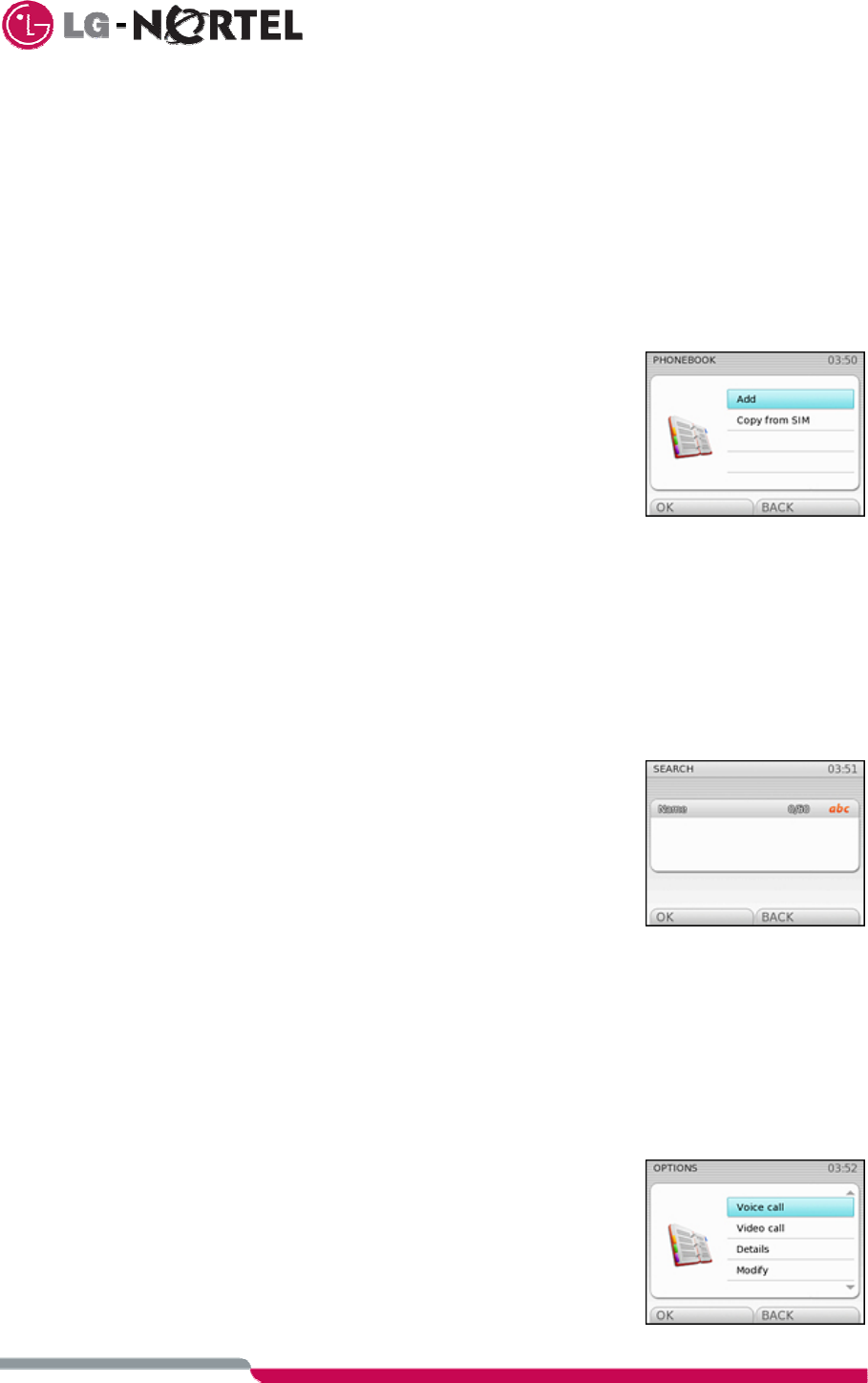
31
11 Phonebook
The IP PHONE 1535 Videophone incorporates a Phonebook capable of storing up to 300 contact entries. For
each record, you can enter a name (maximum 50 letters), a telephone number (primary), a mobile number
(secondary), a fax number and an email address. Each telephone number (main, secondary and FAX) can be
up to 50 digits. The user can select a contact from the Phonebook and call the associated number.
11.1 Adding an entry
To add a new contact to the Phonebook, proceed as follows:
1. Select “main menu” → “organizer” → “phonebook” → “add new”.
2. Enter the name and select “Next”.
3. Enter the telephone number and select “Next”.
4. Enter the mobile number and select “Next”.
5. Enter the email address and select “Next”.
6. Enter the fax number and select “Next”.
The following options will be available:
• Save: to save the data entered.
• Assign melody: to assign a melody to the contact for VIP ring.
• Set as VIP: assigns the contact as a VIP, when the VIP Filter is active, the assigned melody will be
used for ring tone for incoming calls from the contact.
• Assign image: to assign a gallery image to the contact.
11.2 Consulting the Phonebook
You can consult the phonebook with the Videophone On or Off-hook.
11.2.1 Access Phonebook Records
1. Select “main menu” → “organizer” → “phonebook”.
2. Select the “search” option.
3. Enter part or the full name of the desired contact and press OK.
You can move to the first name in the Phonebook that begins with
a certain letter simply by pressing the dial pad key corresponding
to this letter.
Once you have selected the desired contact the following options are
available by selecting “Options”
• Voice Call: places a voice call to the contact.
• Video Call: places a video call to the contact.
• Details: displays details of the contact’s record in the Phonebook.
• Modify: permits modifying the contact’s Phonebook record.
• Delete: deletes the record form the Phonebook.
11.2.2 Quick Access to the Phonebook
An alternative way to access the Phonebook before picking up the handset is to press the key
corresponding to quick access to the Phonebook. To do this:
1. With the Videophone idle, select “phonebook” → “search”
2. Enter part or the full name of the desired contact and press OK.
You can move to the first name in the Phonebook that begins
with a certain letter simply be pressing the dial pad key
corresponding to this letter.
Once you have selected the desired a contact the following options are
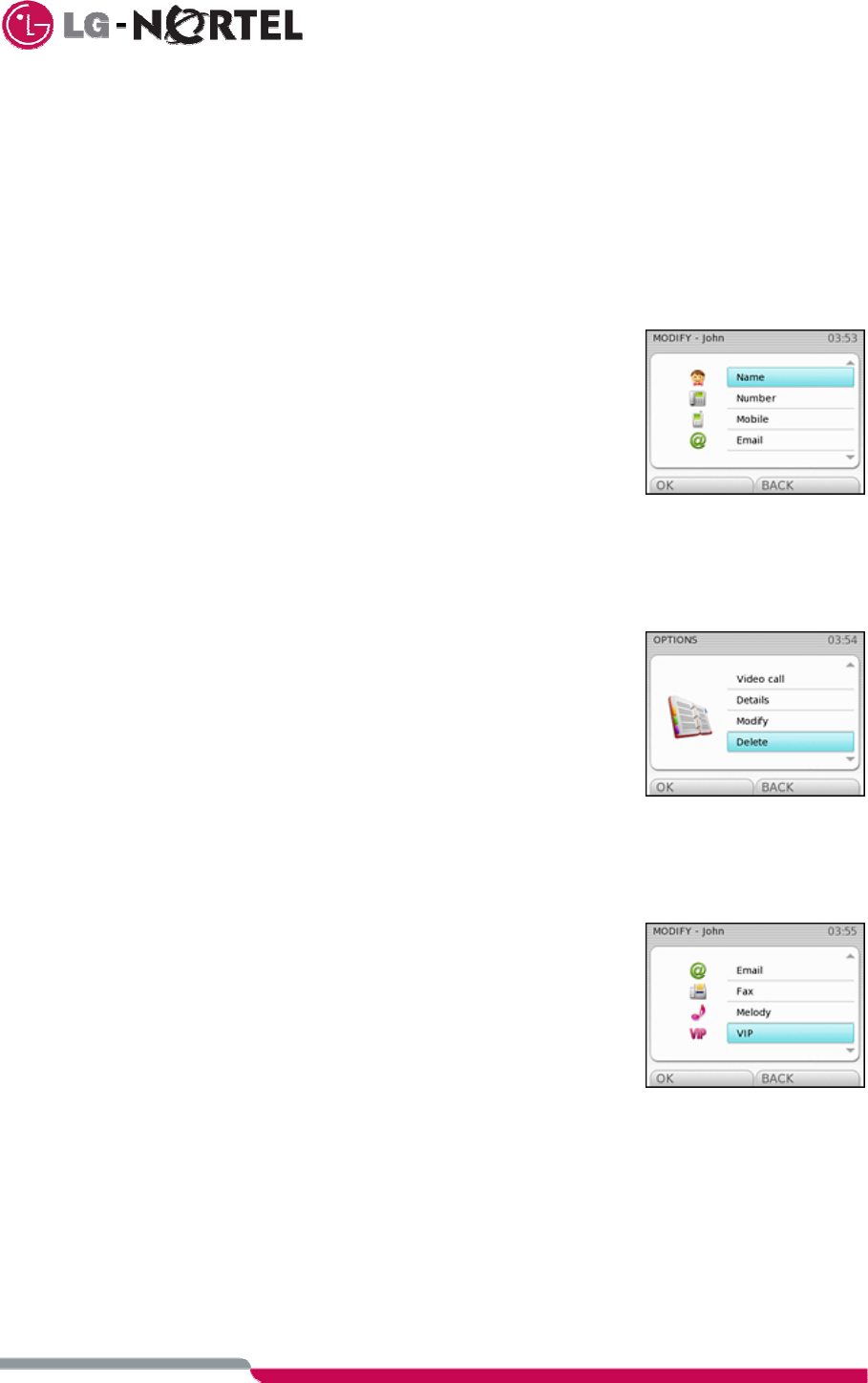
32
available by selecting “Options”
• Voice Call: places a voice call to the contact.
• Video Call: places a video call to the contact.
• Details: displays details of the contact’s record in the Phonebook.
• Modify: permits modifying the contact’s Phonebook record.
• Delete: deletes the record form the Phonebook.
11.3 Modifying an entry
To modify a contact record in the Phonebook:
1. Search for and select the Phonebook entry you want to change.
2. Select the “modify” option and select the item you wish to modify:
• Name: to modify the name associated with the entry.
• Number: to modify the main telephone number.
• Mobile: to modify the mobile number.
• Email: to modify the email address.
• Fax: to modify the fax number.
• Melody: to modify the melody assigned to the entry [only if you have
activated the CLIP service (Calling Number Identification)].
• VIP: to modify an entry’s previous settings.
• Image: to modify the image associated with a phonebook entry.
3. Enter the new data and confirm with OK.
11.4 Deleting an entry
To eliminate a contact from the Phonebook:
1. Search for and select the Phonebook entry you want to delete.
2. Select the “Delete” option and Confirm with OK.
3. To confirm the deletion, selects “YES” or select “NO” to cancel.
11.5 VIP list
If CLI service (Calling Number Identification) is available, the VIP filter can be enabled so that the
Videophone only rings for incoming calls from a number saved in the Phonebook and set as VIP, see section
3.2.2.4. To consult the list of entries set as VIP in the Phonebook or to add entries to the VIP list:
1. Select “Phonebook” from the bottom right of the screen.
2. Select the “VIP list” option (if the Phonebook is empty, this option
will not be available).
3. Select the operation you require from the following options:
• Show VIP: to consult the list of entries already set as VIP.
• Add VIP: to assign a Phonebook entry as a VIP.
• Delete list: to remove a Phonebook entry from the VIP list.
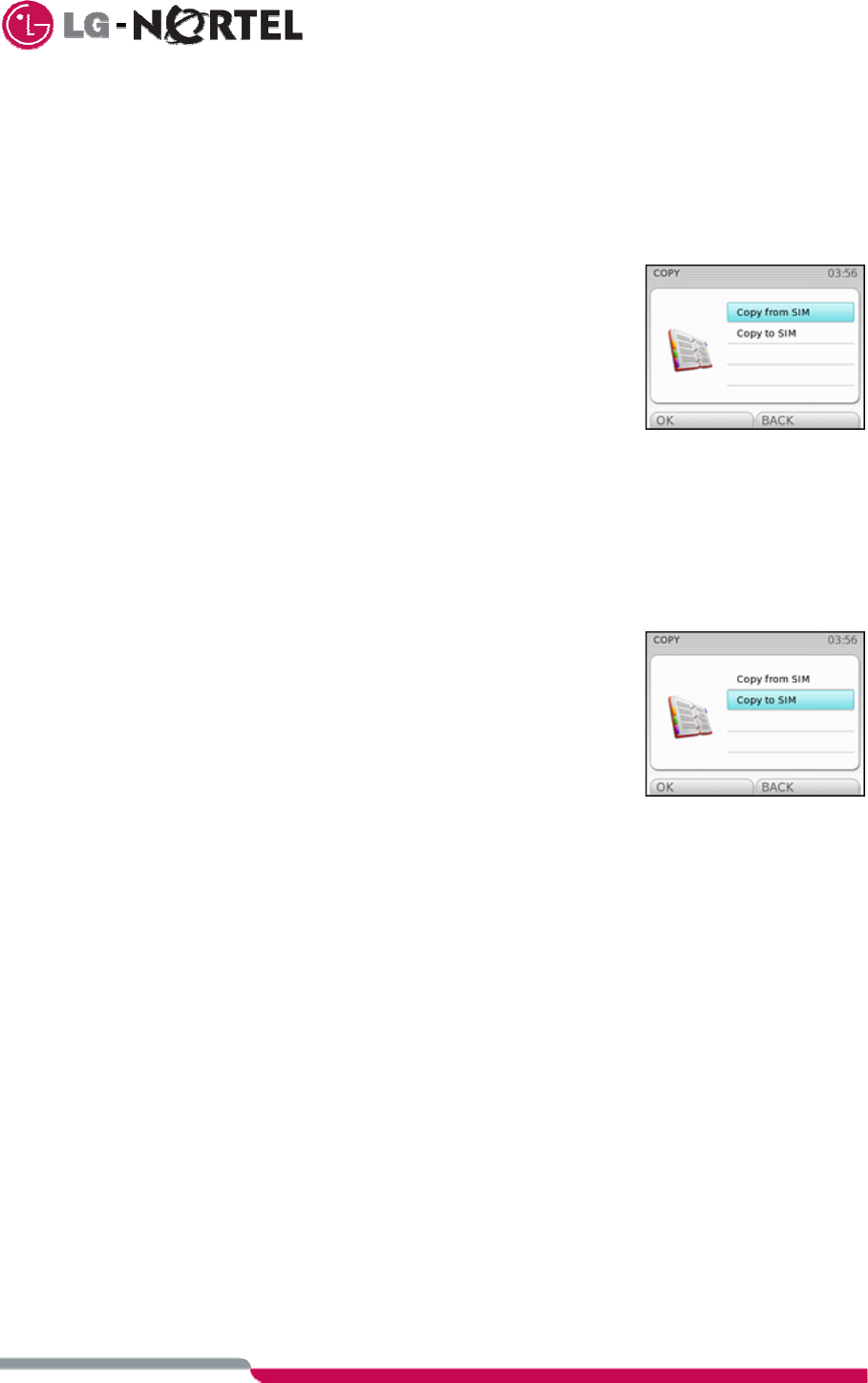
33
12 SIM Card
The IP PHONE 1535 is equipped with an SIM (Subscriber Information Module) card-slot which allows the
Phonebook entries to be copied to or from the card and the Videophone memory.
12.1 Copying entries from the SIM card
To copy Phonebook entries from the SIM card:
1. Insert the SIM card into the SIM card slot, see section 1.1.
2. Select “phonebook” → “copy” → “copy from SIM” and confirm
with OK.
3. Select the entries you wish to copy and confirm with OK:
• All entries: with this option you can make a complete copy of the
SIM card to your Phonebook.
• Certain entries: with this option you can select certain entries from
the SIM card, which will be copied. The Videophone will inform you of how many entries remain
free and will ask you to select them.
The copying process will begin. If you try to copy an entry that already exists, the Videophone will inform you
of this with a message. Also, if there is insufficient memory, an error message will appear.
12.2 Copying entries to the SIM card
To copy Phonebook entries to the SIM card:
1. Insert the SIM card into the SIM card slot, see section 1.1.
2. Select “phonebook” → “copy” → “copy to SIM” and confirm with
OK.
3. Select the entries you wish to copy and confirm with OK:
• All entries: with this option you can make a complete copy of your
Phonebook to the SIM card.
• Certain entries: with this option you can select certain entries in
your Phonebook, which will be copied. The Videophone will inform you of how many entries remain
free and will ask you to select them.
The copying process will begin. If you try to copy an entry that already exists, the Videophone will inform you
of this with a message. Also, if there is insufficient memory, an error message will appear.
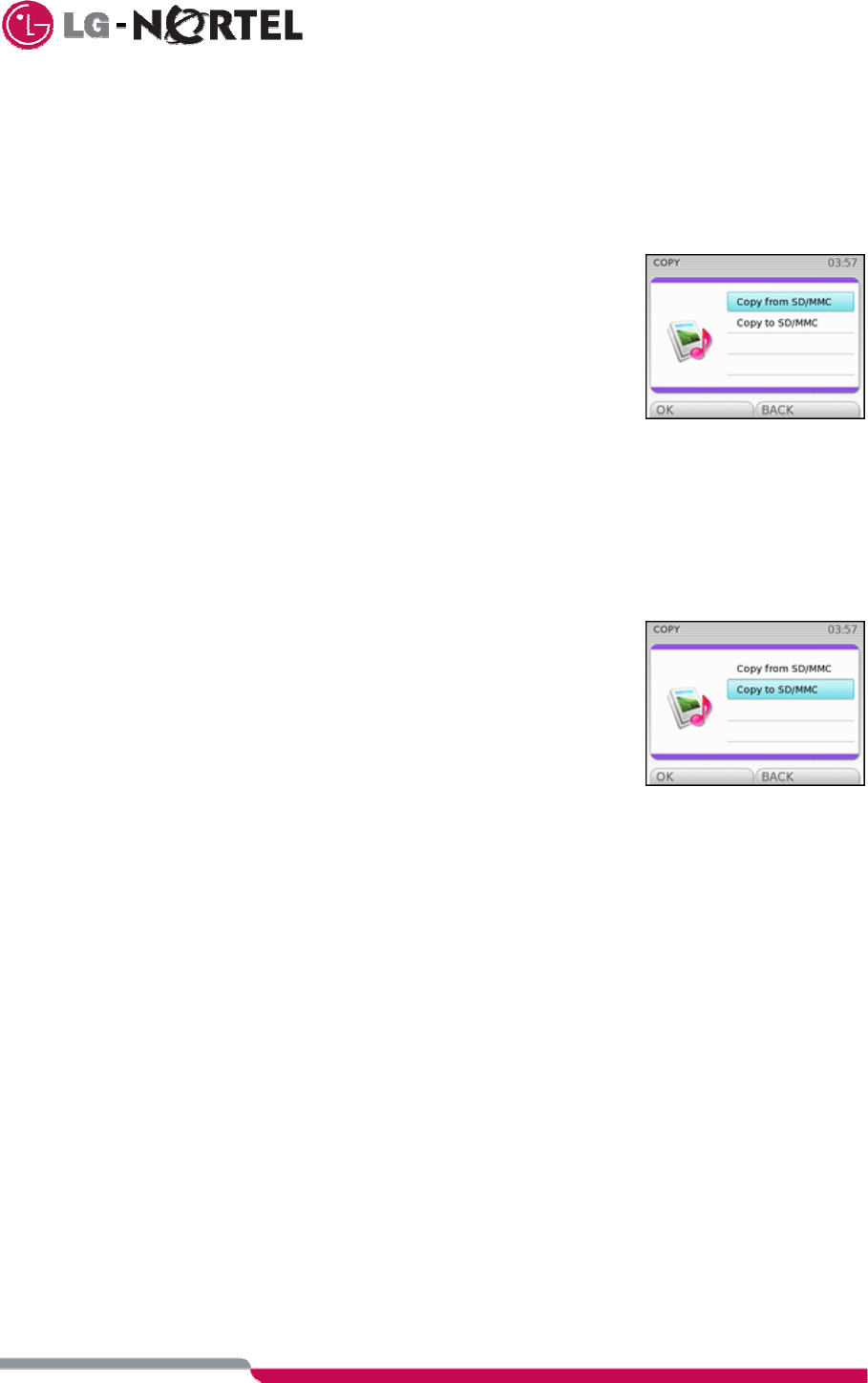
34
13 SD/MMC
The IP PHONE 1535 is equipped with an SD/MMC (Secure Digital Multi-Media Card) slot which allows files to
be copied to or from the card and the Videophone galleries, see section 9.
13.1 Copying files from the Memory card
To copy files from a SD/MMC memory card to your Videophone:
1. Inset the card into the SD/MMC slot (see section 1.1).
2. Select “main menu” → “images and sounds” ~ “copy””
3. Select the gallery (“images”/”sounds”/”videos”) for the file type
you want to copy.
4. Select “Copy from SD/MMC”.
5. Select the files you want to copy and press “Select”.
The copying process will start. When the process has finished, you will be able to access the files copied to
your Videophone.
If the memory is full, an error message will appear.
13.2 Copying files from the videophone to an SD/MMC memory card
To copy files from your Videophone to an SD/MMC memory card:
1. Inset the card into the SD/MMC slot (see section 1.1).
2. Select “main menu” → “images and sounds” → “copy””
3. Select the gallery (“images”/”sounds”/”videos) for the file type
you want to copy.
4. Select “Copy to SD/MMC”.
5. Select the files you want to copy and press “Select”.
The copying process will start. When the process has finished, you will be able to access the files copied
from your Videophone.
If the memory is full, an error message will appear.

35
14 Maintenance and Problem Solving
14.1 What Videophone version do I have?
If you wish to know what the hardware and software version of your Videophone is, see section 3.6.7 Version
Control.
14.2 Updating the Phone’s software
If you wish to update the phone’s software, see section 3.6.7Version Control.

36
FCC Warning
This device complies with part 15 of the FCC Rules. Operation is subject to the following two conditions: (1) This device
may not cause harmful interference, and (2) this device must accept any interference received, including interference that
may cause undesired operation.
Caution! Changes or modifications to the device that are not expressly approved by Nortel will void your warranty and
could void your authority to operate this equipment.